

Malta Travel Guide
Last Updated: August 27, 2024
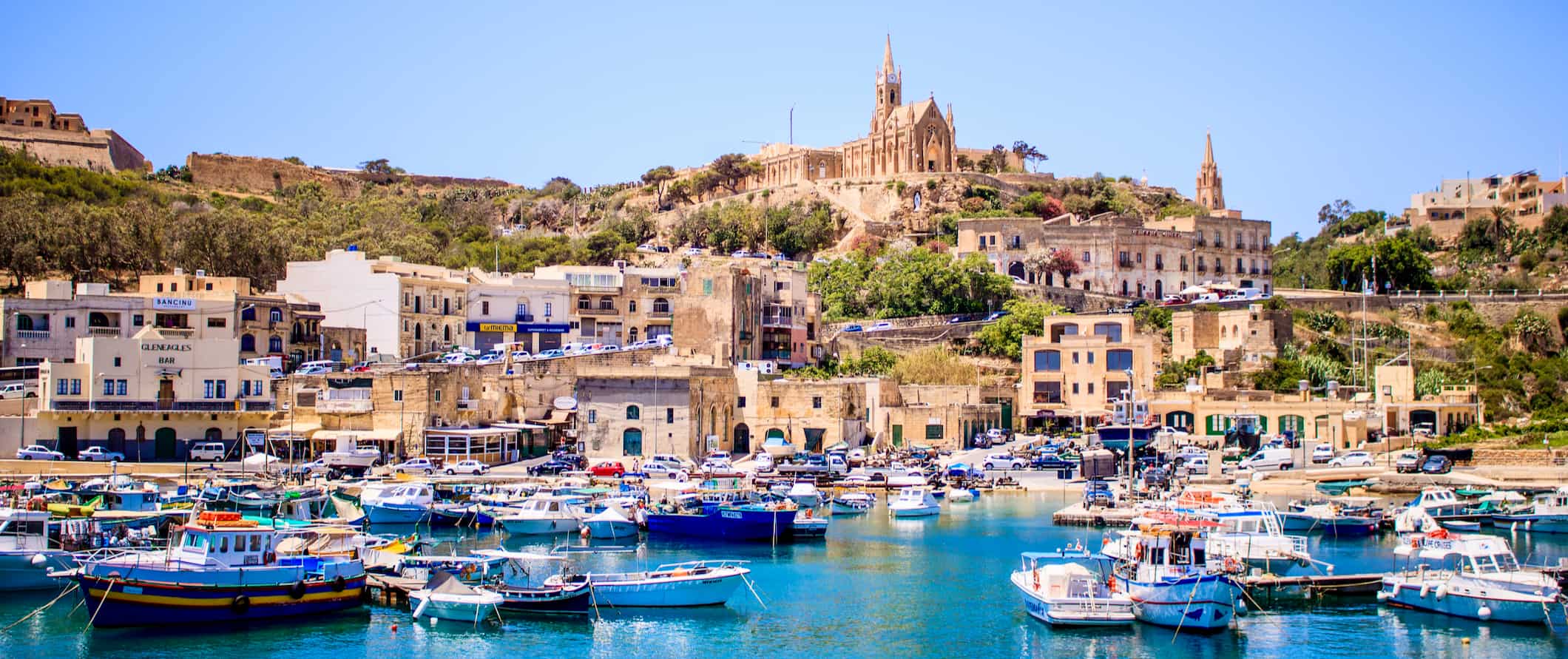
Malta is a popular summer destination for Europeans but, for almost all non-Europeans, it’s mostly ignored for other places in Europe .
While the country has seen a surge in tourism in the last few years (those British retirees were on to something!), it’s still pretty under the radar for most people.
Those folks are missing out. I loved my time in Malta . The tiny island nation boasts friendly people, ancient medieval towns and castles, warm weather, awesome food. and charismatic cities.
Owing to its unique position between Africa and Europe, Malta offers visitors an interesting cultural blend. As you explore, you increasingly notice the Italian, English, and North African elements in the food, language, culture, and architecture.
To top it all off, it’s relatively cheap compared to mainland Europe and the beaches and seafood here are excellent.
This travel guide to Malta will help you plan an epic and affordable trip there.
Table of Contents
- Things to See and Do
- How to Stay Safe
- Where to Stay
- Typical Costs
- Suggested Budget
- Money-Saving Tips
- How to Get Around
- Best Places to Book Your Trip
- Related Blogs on Malta
Click Here for City Guides
Top 5 things to see and do in malta.
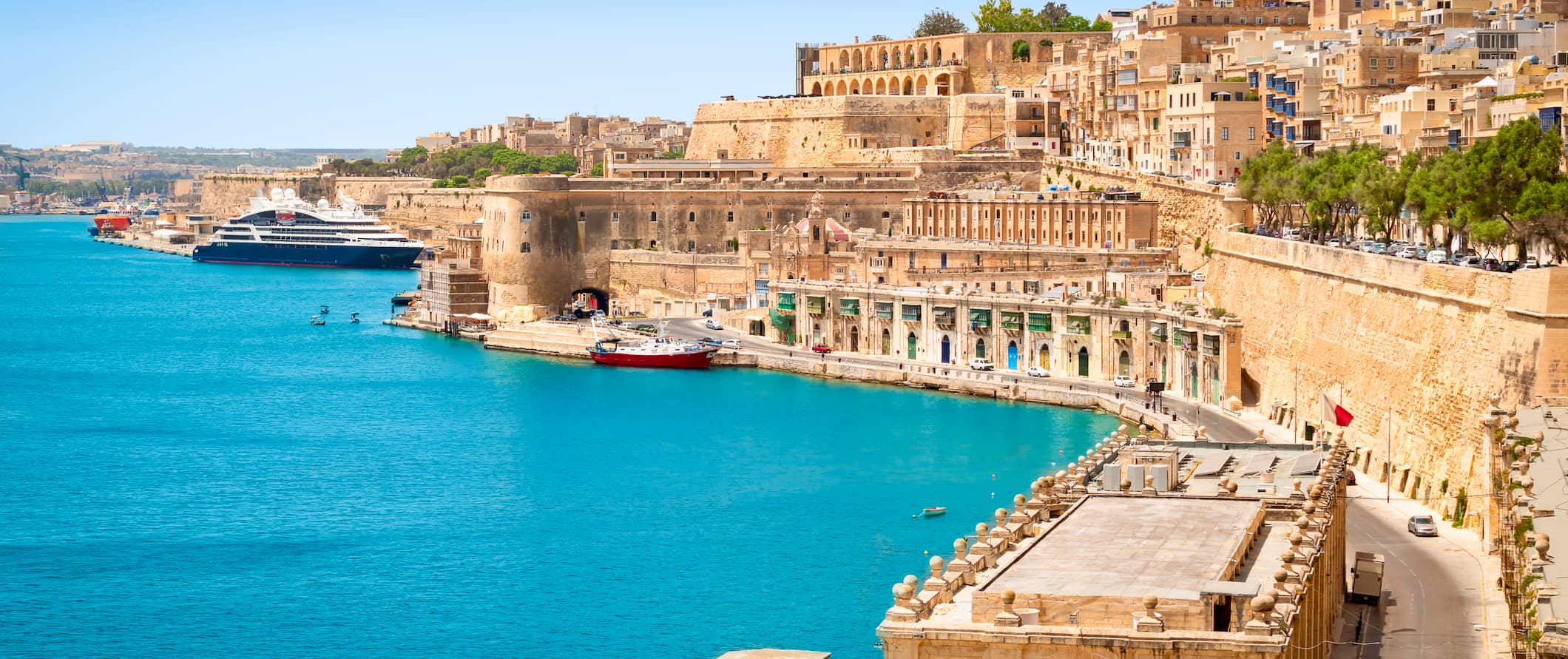
1. Explore Valletta
For Europe’s smallest capital, Valletta packs a big punch: it’s a UNESCO World Heritage Site with over 300 monuments. There’s plenty to see here! Walk the fortifications, wander around St. John’s Co-Cathedral, visit the history museum and the National War Museum, admire the plethora of churches, and dine out on the historical waterfront. Don’t miss the catacombs that were turned into a secret military base during World War II and the Cold War. One of the best things to do though is to just to stroll the narrow roads and alleys and let yourself get lost. If you want to take a guided walking tour of Valletta , they last about 3 hours and cost 20 EUR.
2. Wander Mdina
Mdina is a fortified city and served as the original capital of the country. Like Valletta, it has a beautiful cathedral to visit and lots of old backstreets and passageways to explore. Be sure to visit the nearby catacombs and ancient Roman houses while you’re here. Don’t miss the Knights of Malta museum if you want a quirky and outdated experience (I don’t think this museum has been updated in decades but it’s fun). There’s also the Dungeons Museum where they have recreated scenes from Malta’s long history (note: some of the scenes depict episodes of torture and crucifixion). Admission is 5 EUR. To learn more about the city, take a walking tour of Mdina . They last two hours and cost 18 EUR.
3. Hike a coastal trail in Gozo
The coastal trails in Gozo offer a few different routes around the island for anyone looking for some exercise and stunning panoramic views. All of the walks combine getting back to nature with a bit of exploring history as they take you through some amazing flora and fauna as well as charming towns and villages. If you can only do one, hike from Marsalforn to the (sadly now gone) Azure Window. Keep your eyes peeled for all the traditional salt pans in Xwejni that have been used to harvest salt over the centuries. Other great hikes to check out are the Xlendi Tower, which takes you to an seaside tower that was built in 1650 and the Ras in-Newwiela trail that ends and a stunning stretch of white cliffs overlooking the sea.
4. See the Tarxien Temples
Located near Valletta, this complex is made up of 4 megalithic structures. It’s a UNESCO World Heritage Site and dates back to 3150 BCE. The temples were used for rituals, which may have included animal sacrifices and cremations and some of the walls still have prehistoric artwork on them including bas-relief sculptures and friezes depicting animals and spirals. While mostly ruins and rubble, it’s one of the best ways to learn about the history of the island. Admission is 6 EUR and the Tarxien Temples App has audio guides you can use to navigate your way around. You can also splash out on a private archeology tour if you really want to learn more.
5. Relax on the beach
If you’re visiting in the summer, be sure to schedule some time for the beaches. Golden Bay, Mellieha Bay, and Peter’s Pool are all great places to soak up some rays. The water in Malta is super clear and a brilliant turquoise. Paradise Bay and Armier, on the northern tip, also offer gorgeous views of the island of Gozo. If you have time to get there, the beaches in Gozo are beautiful and don’t get quite as busy as the main beaches in Malta. There’s not always much shade so take plenty of sunscreen and water (although most have at least one place you can buy drinks and snacks). Whichever beach you go to, be sure to arrive early so you can beat the crowds.
Other Things to See and Do in Malta
1. attend the carnival.
Malta has been throwing its own version of Carnival every February for over 500 years! Celebrations are held all around the island during the week leading up to Ash Wednesday, with parades, dancing, and costumes. Much of the population heads to Gozo for the weekend, so be sure to plan ahead as public transportation during that time can be a nightmare (more so than usual). Book your accommodation in advance because everything fills up!
2. Cruise around the island
If you want to get a different view of the island, take a ride around the coast. Tours usually stick to a certain region of the island and the more expensive trips include lunch. They cost from 20-30 EUR, last between 4-8 hours, stop off at a few beaches, and highlight some of the many shipwrecks around the country. Get Your Guide has a great full-day tour that covers all the highlights and gives you three hours of free time to explore on Gozo, if you want to go beyond the beaches.
3. Explore the Citadel
This fort was built by the British in Rabat/Victoria (this is the Rabat on the island of Gozo, not to be confused with Rabat on the main island of Malta). Known as the Cittadella or the Castello, it was built in the 16th century, though fortifications that have been found in this spot go back over 2,000 years (the area was settled in the Bronze Age). Inside, you can see the Cathedral of Gozo and the Bishop’s Palace, along with other historic buildings throughout the winding streets. Some of the damage you’ll see on the structures was actually from Napoleon’s troops in the 18th century, though a fair amount is due to the exposure to the elements. It’s free to enter and explore, with lots of little shops hidden down the alleys. For 5 EUR, you can check out the Visitors Center, the Nature Museum, the Gozo Archaeology Museum, Gran Castello Historic House, and the Old Prisons. The fort offers a great view of the city and surrounding area, making it a good place to come at sunset.
4. Go diving
Malta is surrounded by a plethora of shipwrecks that make for some great diving expeditions. The water in many places is incredibly clear so you have excellent visibility as you explore. Some of the most popular dive sites are the Um El Faroud oil tanker (it was sunk intentionally to act as a reef), the Double Arch cave in Gozo, and the Blue Hole (also in Gozo). You can also dive to see the fallen Azure Window (a famous rock formation that collapsed in 2017). A two-dive package starts around 90-120 EUR per person.
5. Hit the road
Most tourists who visit Malta never stray far from Valletta. If you want to really see the country, rent a car. There are lots of remote places to explore in Malta and a car gives you the freedom to do so. Considering the island is so small, you can just spend the day exploring the aging and battered towns that dot the island . You can find car rentals for as little as 20 EUR per day so it’s an affordable choice if you want to get away from the crowds and see the country beyond Valletta.
6. Relax in the Lower and Upper Barrakka Gardens
I love these gardens. Located in Valletta, on the southern side of the peninsula, they overlook the harbor and make a great place to watch the comings and goings of people and boats. They were created in 1661 as the private grounds for some of the knights that resided here. They were opened to the public in 1824 and are a relaxing nook of the city. Bring a book or a snack, grab a spot on a bench, and watch the world go by. The gardens are full of palm trees and there are different flowers and plants around based on the season. You’ll also see fountains and shaded spots to relax. Don’t miss the Siege Bell Memorial, which was built in 1992 to commemorate the 7,000 people who lost their lives during the Siege of Malta in World War II (the bells chime daily at noon).
7. Explore St. Paul’s Catacombs
Located near Mdina, these underground tunnels were used by the Romans as cemeteries up until the 4th century (and possibly as late as the 7th century). They were built in the 3rd century and are composed of over 30 different areas, 20 of which are open to the public. The entire network of underground passages covers 2,000 square meters. In one of the chambers, you’ll an ornate alter and the two large halls have pillars carved to look like columns. In the Middle Ages, the catacombs were used for religious worship, though they later just became storage areas until their re-discovery in the 1980s. They are an amazing thing to see. I loved them. Don’t miss them! Admission is 6 EUR.
8. Visit the Hypogeum
This is one of Malta’s most popular historical attractions. A UNESCO World Heritage Site, the Hypogeum was carved over 5,000 years ago and was an ancient temple/burial site in the Neolithic Age (over 7,000 bodies have been found here). It’s really cool and the displays provide lots of detailed descriptions and context. The halls, rooms, and passages were carved into three levels from the limestone under the city. In some of the chambers, you can see remaining frescos and other artwork carved into the rock. It is so popular during the summertime (and into the autumn) you need to book your tickets up to four weeks in advance. Admission is 35 EUR and includes a guided tour. It’s one of the best-preserved historical sites in the country and worth every penny. Don’t skip it! It’s just 15 minutes south of Valletta by car.
9. Visit the Blue Lagoon
The Blue Lagoon is situated between Comino and Cominotto (i.e. between the main island and Gozo) and is the most iconic beach in the country because of its pristine white sand beach and turquoise water, which is some of the clearest in the world. It can get incredibly busy here on the weekend, so be sure to come early to stake out a good spot. There is a regular ferry service from Malta, however, if you want to visit from Gozo you need to take a private boat. It takes about 45 minutes to drive to the ferry from Valletta. Half-day catamaran trips to the Blue Lagoon costs from 25 EUR.
10. See the Marsaxlokk fish market
This market happens every Sunday morning. It’s a bit touristy and gets quite crowded but it’s the best place to buy fresh fish. You can find lots of other items such as fresh produce, honey, and other local goods here too. There are plenty of restaurants around (though you should expect to pay tourist prices here). Marsaxlokk is on the southern tip of the main island, about 25 minutes away from Valletta by car.
11. Explore Popeye Village
What started out as the film set for the quirky 1980 Popeye musical starring Robin Williams is now a large tourist attraction. You can explore the village, watch a documentary about its creation, and even play mini-golf. There are actors dressed as characters from the film walking around and interacting with visitors. This is a fun place to go if you’re traveling with kids. You can take boat rides, watch a silversmith demonstration, and bounce around on water trampolines. When the weather is warm, they offer boat rides around the area. Off-peak admission is 15 EUR while peak-season admission is 24 EUR.
12. See the Gozo Salt Pans
Lining the coast of Gozo, these salt pans have been in use for over 350 years. The traditional methods of harvesting salt have been passed down for generations, and even to this day you can find locals engaged in harvesting the crystals. There is salt for sale in shops all around the island (it’s a great souvenir to take home).
13. Visit the Three Cities
Vittoriosa, Senglea, and Cospicua trace their origins back to the Middle Ages and have been inhabited more or less since people arrived on the island. The Three Cities were also the original home of the Knights Hospitallers (a Catholic military order known as the Knights of Malta) and feature a lot of wonderful architecture and history. They aren’t as visited as other destinations on the island so it can be a good way to get away from the crowds. They’re just across the water from Valletta. Half-day tours of the Three Cities cost 36 EUR.
How to Stay Safe in Malta
Malta consistently ranks as one of the safest countries in the world. Crime is rare, though it’s always a good idea to keep your wits about you. Petty theft can still occur so always keep your valuables tucked away and be mindful of your things while on crowded public transportation or while swimming at the beach.
When swimming, make sure you only swim in areas where there are other swimmers around. Riptides are common so it’s best to avoid secluded beaches unless you can be sure that it’s safe. Never swim when the sea is rough and never swim alone.
Drivers in Malta are on the aggressive side so take extra precautions when crossing roads, cycling, or renting a car. When taking a taxi, always wear your seatbelt.
Solo female travelers should generally feel safe here. However, the standard safety precautions apply (never leave your drink unattended at the bar, never walk home alone intoxicated, etc.). There are a lot of helpful solo female travel blogs on the web that can give you specific tips and information about a place that I can’t.
If you’re out hiking in the spring or autumn, be aware that it is hunting season (just for small birds).
If you rent a car, don’t leave any valuables in it overnight. Break-ins are rare but it’s always better to be safe than sorry.
Scams here are very rare here but you can read about common travel scams to avoid here .
If you experience an emergency, dial 112 for assistance.
The most important piece of advice I can offer is to purchase good travel insurance. Travel insurance protects you against illness, injury, theft, and cancellations. It’s comprehensive protection in case anything goes wrong. I never go on a trip without it as I’ve had to use it many times in the past. You can use the widget below to find the policy right for you:
Where to Stay in Malta
While hostels aren’t plentiful, you can find them around Valletta. There’s a lot of budget hotels too. Here are some of my recommended places to stay:
- Inhawi Hostel (St. Julian’s)
- Two Pillows Boutique Hostel (Sliema)
- Corner Hostel Sliema (Sliema)
- Tritoni Valletta Boutique Hotel
- Ddream Hotel
Malta Travel Costs
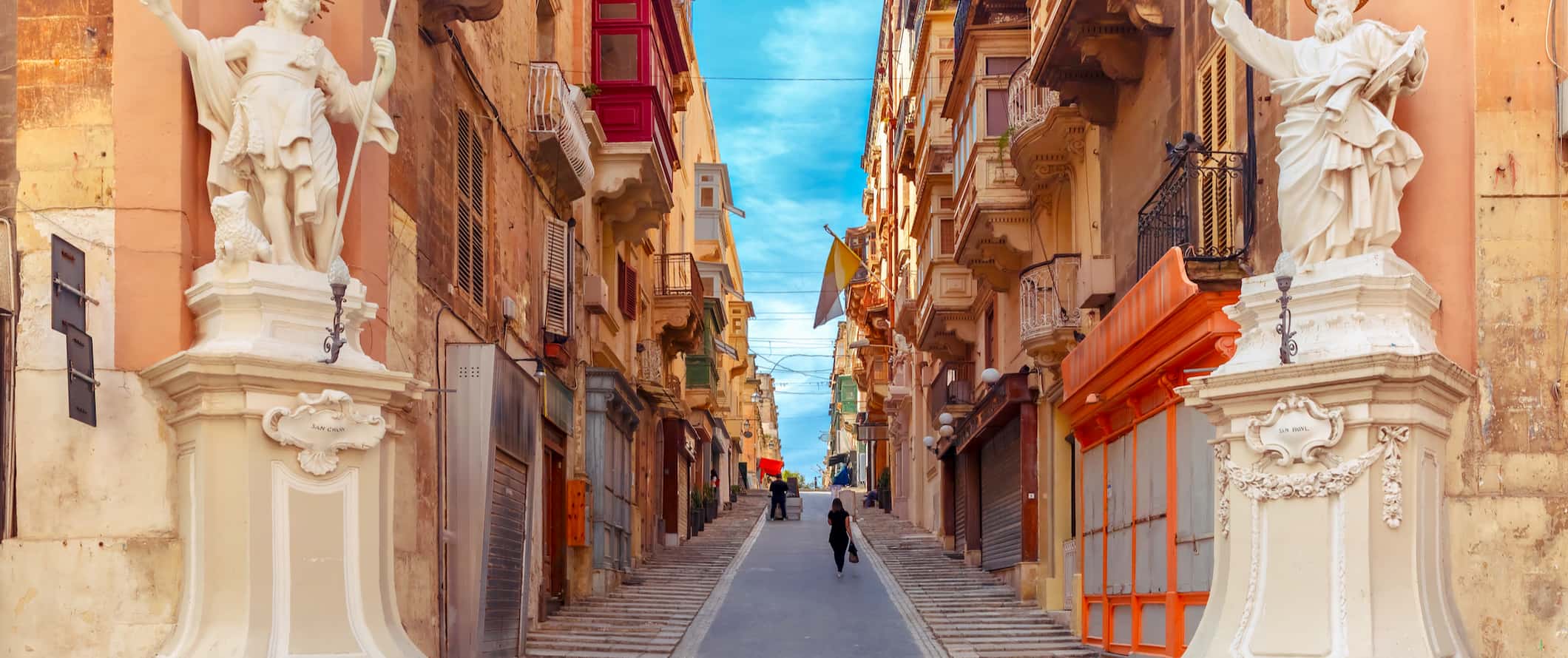
Accommodation
- Hostel Dorms – 20-60 EUR per night (double during summer)
- Budget hotels – 65 EUR per night
- Airbnb private rooms – 25 EUR per night
- Airbnb apartments – 60-80 EUR per night (50-100% more during summer)
- Street food – 1-7 EUR
- Sit-down restaurants – 35 EUR
- Casual take-out places – 15 EUR
- Fast food (think McDonald’s) – 9.50 EUR
- Beer – 4 EUR
- Glass of wine – 3-6 EUR
- Cappuccino/latte- 2.50 EUR
- Bottled water – 1.50 EUR
- Groceries for a week – 30-50 EUR
Malta Suggested Budgets
Backpacker – 55 eur per day.
On a backpacker budget, you can stay in a hostel dorm, cook all your meals, and use public transportation to get around. You’ll need to limit your drinking and stick to free or cheap activities like hitting the beach and visiting museums.
Midrange – 135 EUR Per Day
On a mid-range budget, you can stay in a private Airbnb or budget hotel. You’ll still need to cook most meals and eat out occasionally at cheap fast-food joints. You’ll be able to enjoy a few drinks, rent a car to get around, and do more paid activities like boat tours or museum visits.
Upscale – 245 EUR Per Day
On a “luxury” budget, you’ll be able to drink as much as you’d like, eat out for all your meals, rent a car to get around, and do more activities like scuba diving and visiting Popeye Village. This is just the ground floor for luxury though!
Malta Travel Guide: Money-Saving Tips
Malta is one of the more affordable destinations in Europe but, during the summer months, it gets really expensive. To help you stick to your budget, here are some money-saving tips and tricks for visiting Malta:
- Visit during the off-season – Malta (or at least Valletta) gets crowded in the summer and prices tend to rise (cruises stop here). If you want to save money and have a less hectic visit, visit during the off-season.
- Cook your own meals – While restaurants aren’t overly expensive, eating out every day adds up. Try cooking your own meals to save some money. There are plenty of small shops and larger supermarkets (like Lidl) where you can grab basic staples for cheap.
- Avoid supermarket produce – A lot of produce at the supermarket is imported (and thus more expensive). Search out local vendors who sell their produce at the side of the road or at small stalls in town. It’s cheaper and fresher!
- Get a tallinja transit pass – The tallinja card can save you money on bus trips, if you want to explore beyond the major cities of the island. While a single trip is 2.50 EUR you can get a 24-hour pass for 6 EUR. There’s also a 7-day pass for 25 EUR. You can also buy twelve single trips for 21 EUR which saves over buying each one individually.
- Get the Malta Pass – This tourism card provides free entry to Malta’s top 40 attractions, making it worthwhile for anyone who plans on visiting a lot of sites. It also includes a free sightseeing bus (which is worth 20 EUR itself). You can get a 1-, 2-, or 3-day pass for 50 EUR, 80 EUR, or 100 EUR respectively. Buy it online before you go for the best price.
- Take a free walking tour – There are a few tour companies in Valletta, such as Colour My Travel , who offer free 1.5-hour walking tours. You get to explore the area and learn about the local culture, history, and architecture from a local expert. It’s a great introduction to Malta and definitely worth doing. Just be sure to tip!
- Redeem hotel points – You can sign up for a hotel credit card and use the points you earn toward accommodation when you travel. Most cards come with at least 1-2 free nights when you sign up, which can help you save a lot. Here’s a post that will help you get started with hotel credit cards . If you start earning points now, you’ll have plenty for your trip.
- Skip the taxis – Taxis in Malta are not cheap. Avoid them as much as possible. If you do need to use them, get the eCab app. It ensures you get a reputable and reliable taxi (they are good for short distances while taxis are likely cheaper for longer journeys).
- Bring a water bottle – The tap water here is safe to drink (though it tastes a little off). Bring a reusable water bottle to save money and reduce your plastic use. LifeStraw is my go-to brand as their bottles have built-in filters to ensure your water is always clean and safe.
How to Get Around in Malta
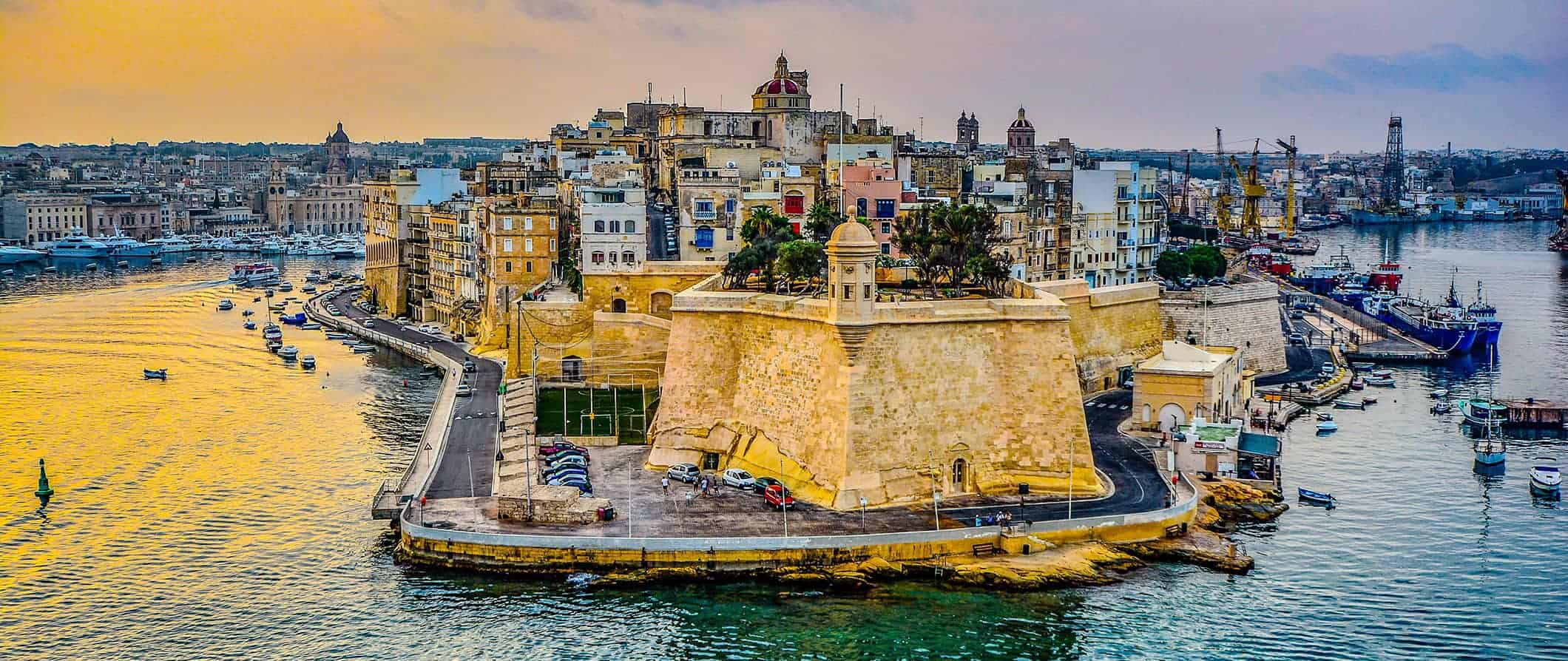
Public transportation – Public buses go pretty much everywhere in Malta (albeit not regularly). A single fare is 2.50 EUR during the day and 3 EUR at night. You can also purchase a pass with 12 trips for 21 EUR. Just keep in mind that they fill up fast so you might have to stand for your trip. They also can be infrequent and pass by stops without warning if they’re full, so if you are taking the bus make sure you have lots of extra time!
In addition to the public buses, there are also hop-on/hop-off buses that have different routes around the country. These routes cover all the major sites on both islands (Valletta, St. Julian’s, Popeye Village, the former Azure Window, etc.). A day pass for a single route starts at 25 EUR with Hello Malta or 28 EUR with City Sightseeing. I’d skip this and just use the public bus.
Ferry – The ferry to Gozo costs 4.65 EUR and takes 25 minutes. Be sure to arrive in advance as it fills up fast. The ferry from Malta to Italy takes less than 2 hours and costs 50-80 EUR (depending on the time of year) EUR for a one-way ticket to Sicily.
Bike – You can rent bikes for around 15 EUR per day, though I’d be extra careful cycling outside of Valletta. Drivers here are aggressive and the roads are quite narrow.
Taxi – Taxis start at 5 EUR and cost around 2 EUR per kilometer. There are no Uber or Lyft here but you can download the eCab app as an alternative. It’s usually cheaper than taxis for short distances. However, if you’re on a budget, it’s best to just avoid taking them.
Flying – Flights from Malta to and from mainland Europe can be found for as little as 45 EUR if you book early. Ryanair is the most budget-friendly airline that flies to Malta so they are your best choice if you’re on a budget. Flights to and from Morocco and North Africa can be found for as little as 55 EUR per person (again, if you book early and are flexible). There are no domestic flights around Malta.
Car rental – Car rentals cost between 20-25 EUR per day for a small car. Just keep in mind that the cheapest rentals are manual transmissions so you need to be able to drive stick if you want to get around. The drivers here are also very aggressive and tend to see the rules of the road as suggestions rather than laws. Renters need to be at least 21 years old.
For the best car rental prices, use Discover Cars .
Hitchhiking – Hitchhiking in Malta is not recommended, simply because people just don’t stop. If you do want to try your hand at it, check out Hitchwiki for tips and information.
When to Go to Malta
The best time to visit Malta is from June to August. The weather is the warmest then, with daily temperatures around 31°C (88°F). Not surprisingly, this is also the busiest time of the year so expect crowds and higher prices.
In August, as in much of Europe, many locals leave for their own summer holidays. A lot of shops and restaurants close, which can crowd the remaining places even more. But the weather is perfect and most tourist attractions stay open. If you choose to visit during the busy summer months, the Mediterranean Food Festival happens in August. This event features cuisines from around the world with cooking competitions, talks about sustainability, and displays by local artists. In late July and early August, you can also check out the Farsons Beer Festival, which is a totally free to enter. There’s plenty of live music, food, and beer.
The shoulder months of April-May and September-October offer a nice compromise of decent weather and fewer crowds. Expect temperatures around 25°C (77°F). Carnival is a major spring even and has been celebrated in Malta for more than 500 years. During the week leading up to Ash Wednesday (about seven weeks before Easter), there are masquerade competitions, parades, parties, and masked balls. In late April and early may there’s the Malta Fireworks Festival. There are incredible fireworks displays and competitions that happen over the course of these two to three weeks. In the fall, the island of Gozo puts on the Festival Mediterranea. This is a celebration of the arts that have been a part of Gozo’s culture for more than 7,000 years. There are operas, symphonies, poetry readings, and so much more.
The winter in Malta is chilly, with temperatures dropping to 10-15°C (48-60° F) — sometimes colder. Aside from attractions closing for Christmas, everything is open though some bus schedules change to reflect the lower number of visitors in the country. In short, it’s a perfect time to visit as long as you aren’t looking to hit the beach and don’t mind some windy sweater weather.
Malta Travel Guide: The Best Booking Resources
These are my favorite companies to use when I travel. They consistently have the best deals, offer world-class customer service and great value, and overall, are better than their competitors. They are the companies I use the most and are always the starting point in my search for travel deals.
- Skyscanner – Skyscanner is my favorite flight search engine. They search small websites and budget airlines that larger search sites tend to miss. They are hands down the number one place to start.
- Hostelworld – This is the best hostel accommodation site out there with the largest inventory, best search interface, and widest availability.
- Booking.com – The best all around booking site that constantly provides the cheapest and lowest rates. They have the widest selection of budget accommodation. In all my tests, they’ve always had the cheapest rates out of all the booking websites.
- HostelPass – This new card gives you up to 20% off hostels throughout Europe. It’s a great way to save money. They’re constantly adding new hostels too. I’ve always wanted something like this and glad it finallt exists.
- Get Your Guide – Get Your Guide is a huge online marketplace for tours and excursions. They have tons of tour options available in cities all around the world, including everything from cooking classes, walking tours, street art lessons, and more!
- The Man in Seat 61 – This website is the ultimate guide to train travel anywhere in the world. They have the most comprehensive information on routes, times, prices, and train conditions. If you are planning a long train journey or some epic train trip, consult this site.
- Rome2Rio – This website allows you to see how to get from point A to point B the best and cheapest way possible. It will give you all the bus, train, plane, or boat routes that can get you there as well as how much they cost.
- FlixBus – Flixbus has routes between 20 European countries with prices starting as low 5 EUR! Their buses include WiFi, electrical outlets, a free checked bag.
- SafetyWing – Safety Wing offers convenient and affordable plans tailored to digital nomads and long-term travelers. They have cheap monthly plans, great customer service, and an easy-to-use claims process that makes it perfect for those on the road.
- LifeStraw – My go-to company for reusable water bottles with built-in filters so you can ensure your drinking water is always clean and safe.
- Unbound Merino – They make lightweight, durable, easy-to-clean travel clothing.
- Top Travel Credit Cards – Points are the best way to cut down travel expenses. Here’s my favorite point earning credit cards so you can get free travel!
GO DEEPER: Nomadic Matt’s In-Depth Budget Guide to Europe!

There’s a lot of free information online but do you want to spend days searching for information? Prob not! That’s why guidebooks exist.
While I have a lot of free tips on Europe, I also wrote an entire book that goes into great detail on everything you need to plan a trip here on a budget! You’ll get suggested itineraries, budgets, even more ways to save money, my favorite restaurants, prices, practical information (i.e. phone numbers, websites, prices, safety advice, etc etc), and cultural tips.
I’ll give the insider view of Europe that I got from years of traveling and living here! The downloadable guide can be used on your Kindle, iPad, phone, or computer so you can have it with you when you go. Click here to learn more about my book on Europe!
Malta Travel Guide: Related Articles
Want more tips for your trip? Check out all the articles I’ve written on Malta travel and continue planning your trip:
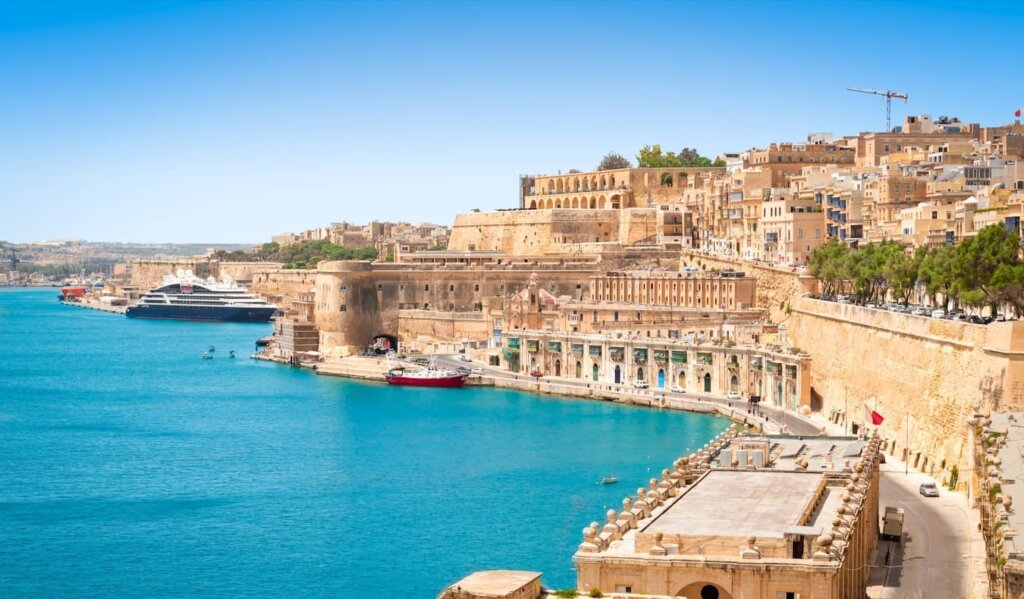
How to Visit Malta on a Budget
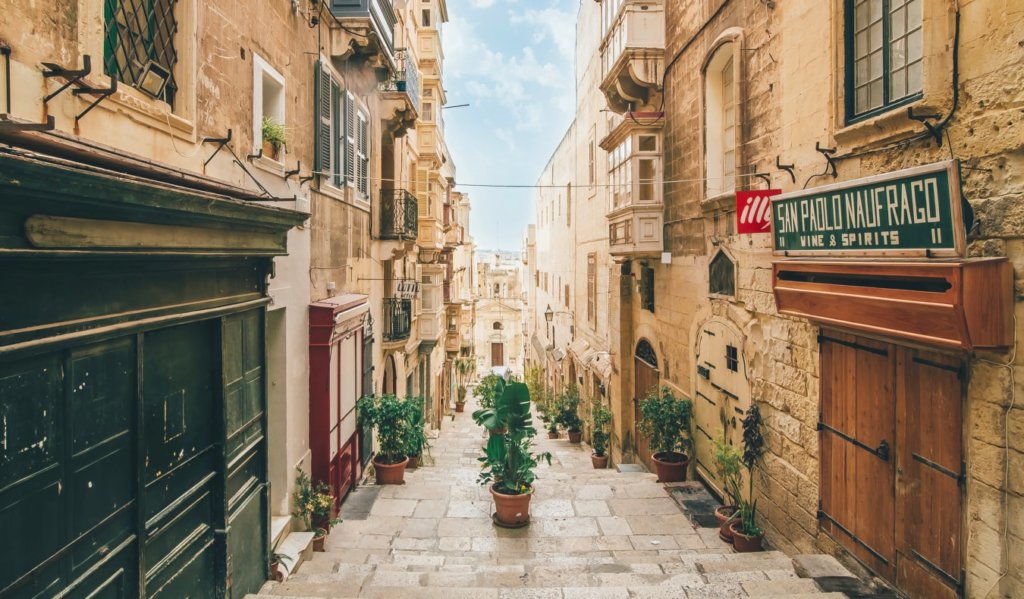
Malta: The Country of Half-Neglected Buildings
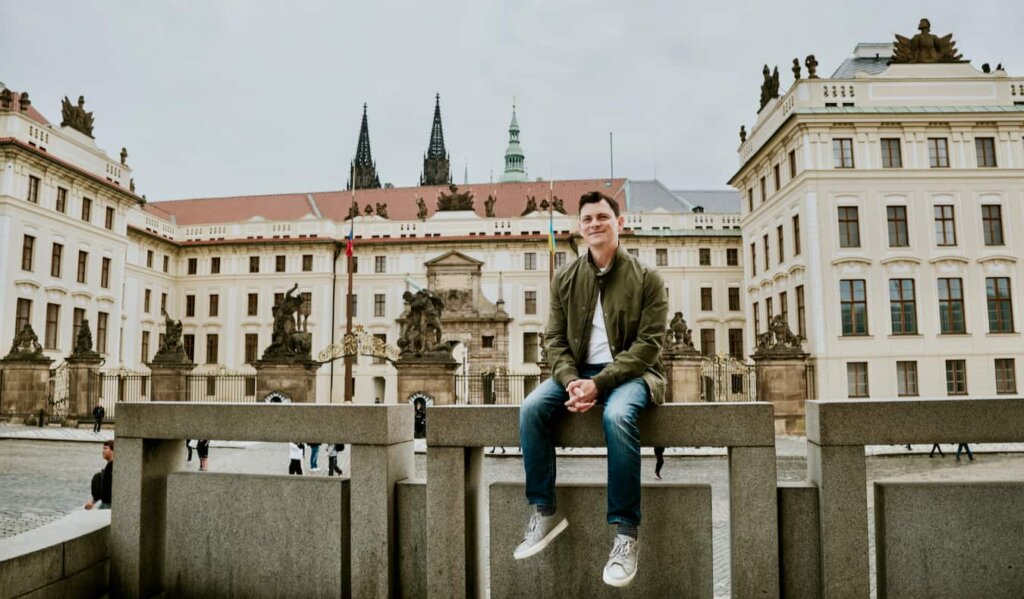
My Step-By-Step Guide to Backpacking Europe
Get your free travel starter kit.
Enter your email and get planning cheatsheets including a step by step checklist, packing list, tips cheat sheet, and more so you can plan like a pro!

- Where To Stay
- Transportation
- Booking Resources
- Related Blogs

A week in Malta: The perfect 7-day Malta itinerary
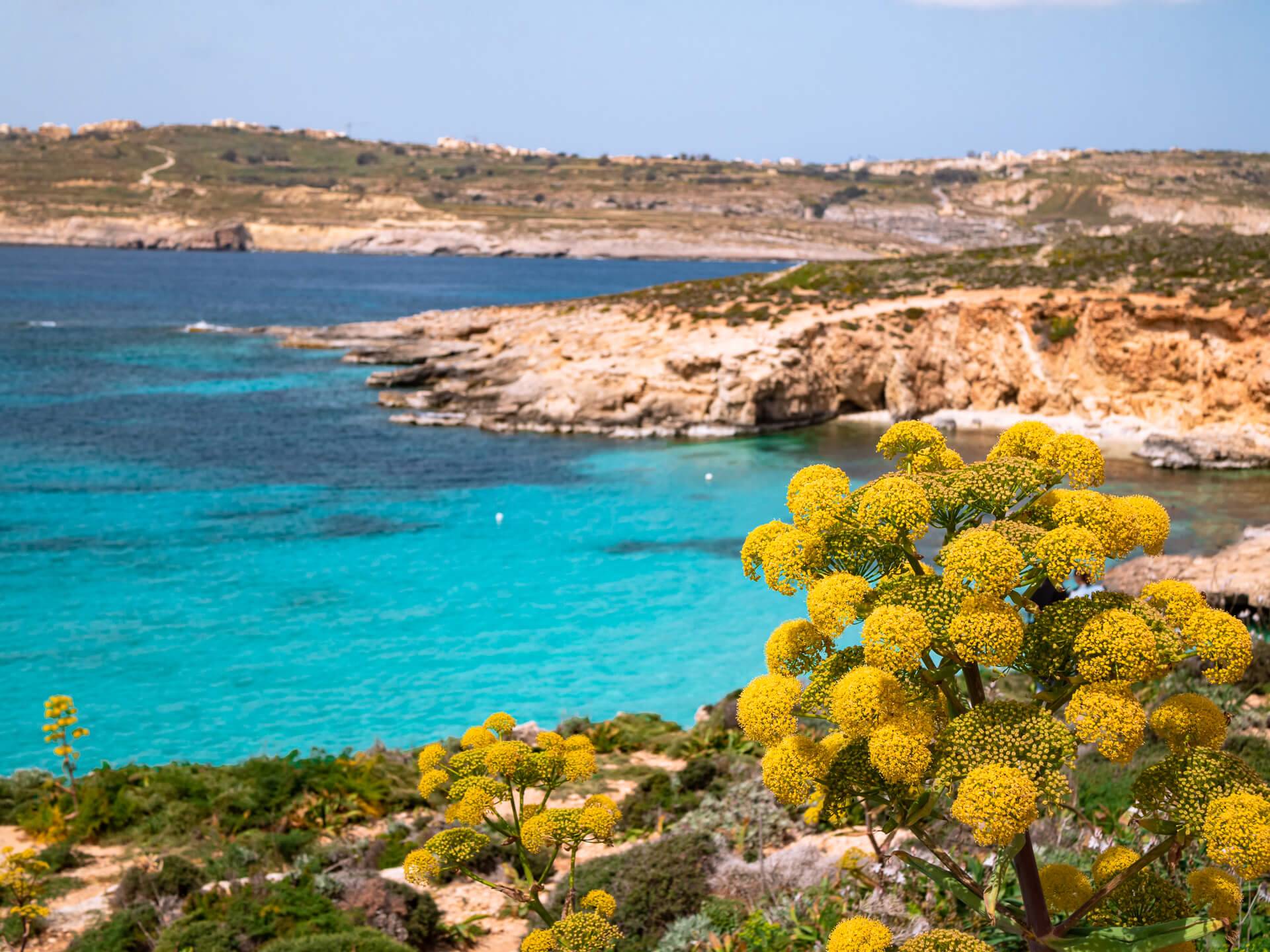
I have to admit that I didn’t know much about Malta before I started planning my trip there. I knew it was an island nation in the Mediterranean Sea but that was about it. After spending a week in Malta, exploring the different corners of the archipelago, I was blown away by how much this tiny country has to offer!
In this post, I’m sharing a 7-day Malta itinerary that will take you to the most beautiful places on the Maltese islands – from gorgeous beaches and natural marvels to picturesque medieval towns and epic viewpoints.
Malta lies about 80 kilometers (50 miles) south of Sicily and consists of three islands – Malta, Gozo and Comino. With a total area of 316 km2, it is one of the smallest countries in the world.
Despite its compact size, Malta has a fascinating history and cultural heritage. It was ruled by the Phoenicians, the Romans, the Arabs, the British Empire and others, who all left their mark on the country. You can clearly notice it in the Maltese language, which is of Arabic origin and also uses words derived from Italian, English and French.
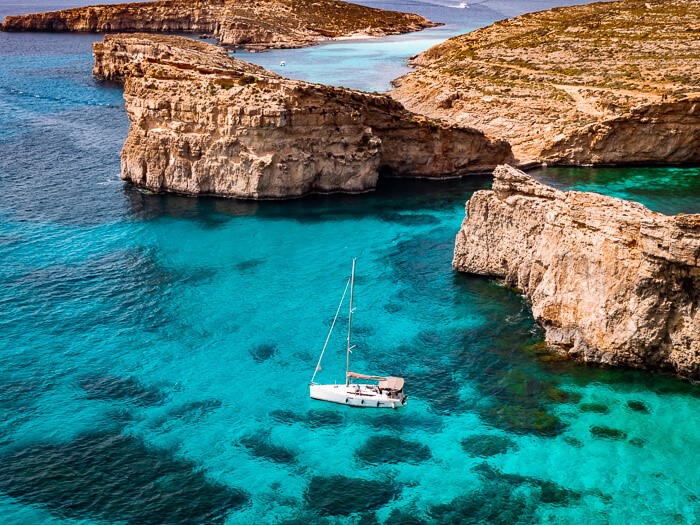
With one week in Malta, you can visit all the main attractions on the island. But you could easily spend two weeks and not run out of things to do, especially if you also want to have some lazy days at the beach. You’ll find my tips for what to do if you have more than 7 days in Malta at the end of the post.
In the itinerary below, I’ve outlined the best things to do on each of the 7 days and provided my recommendations on where to stay. I’ve also included a map with the exact locations of all the stops on this one-week Malta itinerary.
Disclosure: This article contains affiliate links from which I may make a commission at no additional cost to you if you make a purchase.
Getting around Malta
The easiest and most efficient way to explore the island is to rent a car and embark on a Malta road trip. Not only is it the fastest way to get around but it will also give you the freedom to stop wherever you want.
Driving in Malta is safe and relatively easy, and overall the roads are in good condition (unless you accidentally end up on some bumpy backcountry roads). Just be aware that you need to drive on the left side. Also, in cities like Sliema and Valletta, some of the streets are very narrow and there’s not a lot of parking space so it’s better to leave your car behind and explore these places on foot.
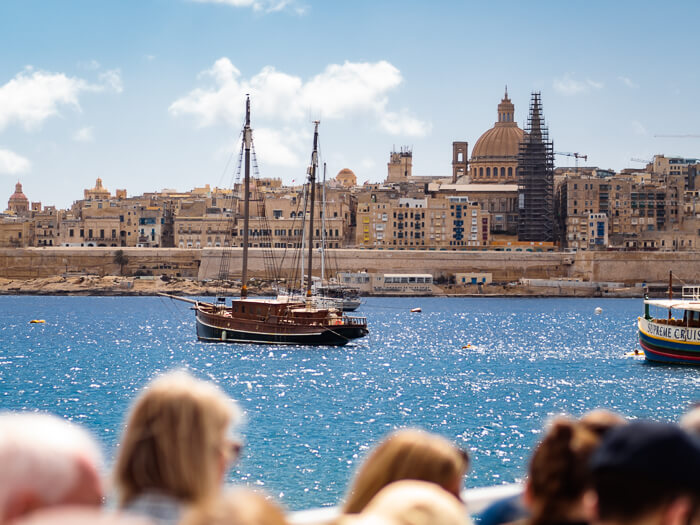
It’s also possible to travel around Malta by bus but it would take you longer to get from one place to another and it would be difficult to reach some of the more remote spots. If you’d only like to visit the most popular tourist attractions and bigger cities, and you’re not short on time, then you could definitely consider using the public bus network or this hop-on hop-off bus .
Since this 7-day Malta itinerary includes some relatively remote places (as well as the popular attractions), it is best done as a road trip. However, with some adjustments, you can still follow this route even if you don’t plan to rent a car.
Malta itinerary: How to spend a week in Malta
Day 1: valletta and the three cities.
On the first day of your Malta trip, I recommend visiting the beautiful capital city Valletta. Since Valletta is very small (it’s the smallest capital in the EU!), it is best explored on foot. Therefore, there’s no need to rent a car for the first day.
Built in the 16th century, the city of Valletta is a UNESCO World Heritage Site and is packed with architectural marvels. The most important historical landmarks here are the Grandmaster’s Palace (currently being renovated) and St. John’s Co-Cathedral with its ornate Baroque interior.
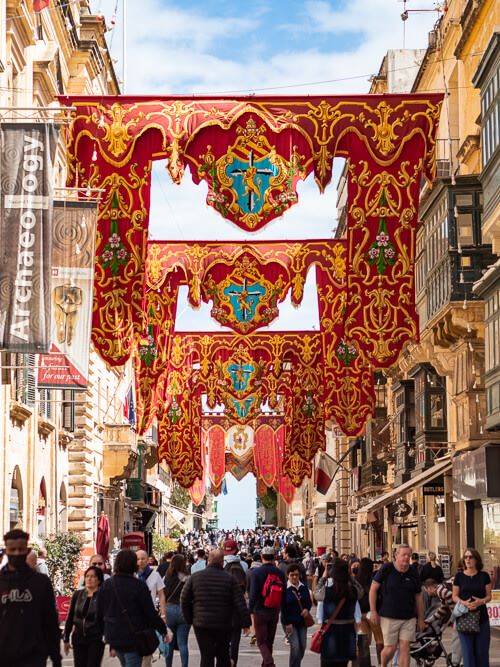
Take your time to wander around the narrow hilly streets and admire the medieval buildings decorated with colorful wooden balconies. Along the bustling Republic Street, which is the city’s biggest and busiest street, you’ll find countless restaurants, cafes and shops.
Another must-visit spot in Valletta is the Upper Barrakka Gardens. This public park is not only a great place to relax but it also offers a stunning view of the Grand Harbor and the neighboring towns of Vittoriosa, Senglea and Cospicua – collectively known as the Three Cities. Every day at noon and at 4pm, you can watch a cannon being fired at the Saluting Battery right next to the park.
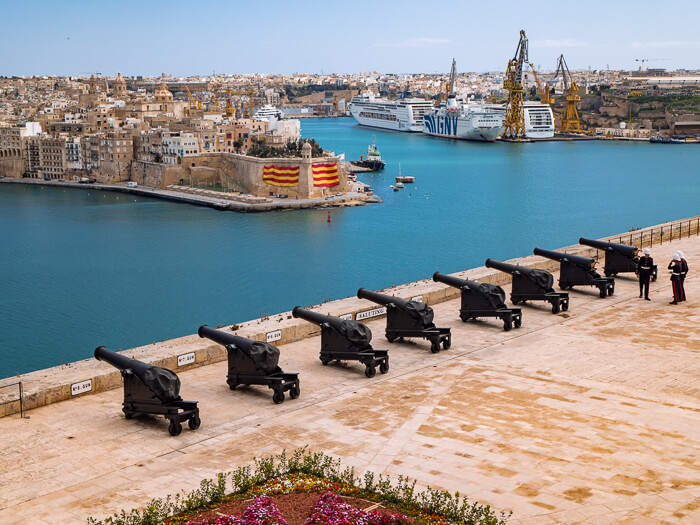
If you’d like to learn about the history of Valletta (and also sample some local specialties like pastizzi ), consider taking one of these guided tours below:
To visit the Three Cities, you can simply take the ferry that departs across the street from the Barrakka Lift. These ferries depart every 30 minutes and the scenic journey takes only 10 minutes. I didn’t have time to visit the three cities but I’ve heard that they are lovely little towns with quaint alleyways, spectacular views and an authentic vibe.
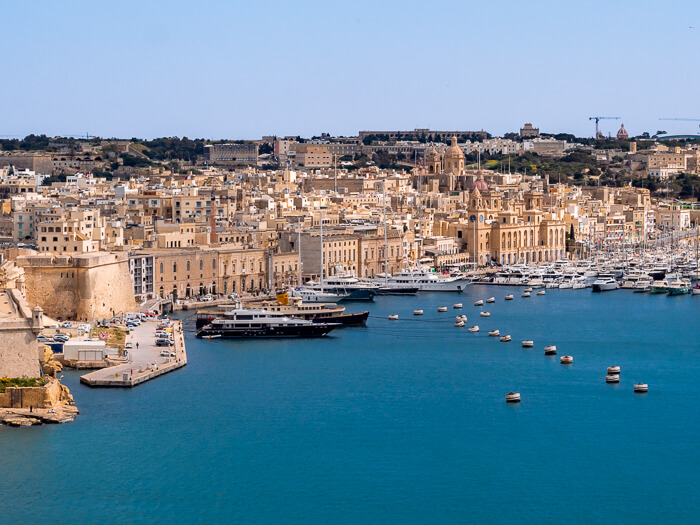
Where to stay
Spend the night in Valletta. Be aware that accommodation options here are rather limited and rooms tend to get sold out very quickly, especially in the summer. If you want to be sure that you get to spend a night in Valletta, book your room several months in advance.
MID-RANGE: Casa Asti Casa Asti is set in a charming 400-year-old building, just a short walk from the center of the city. It’s a family-run guest house and their quirky rooms are absolutely adorable. This place offers excellent value for money.
LUXURY: The Embassy Valletta Hotel This wonderful hotel is located in the heart of Valletta’s historic center and has elegant spacious rooms. But the best part about this place is their rooftop with a heated pool and a phenomenal view over Valletta.
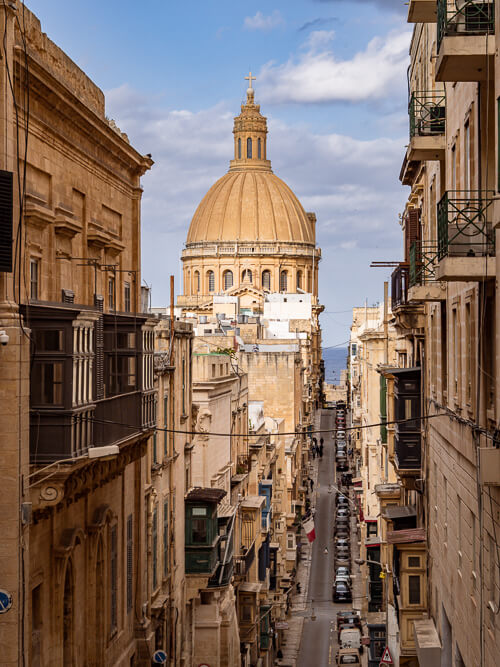
Day 2: Blue Grotto, Marsaxlokk and St. Peter’s Pool
On Day 2 of your Malta itinerary, pick up your rental car and explore the southern coast of the island.
Start by visiting the Blue Grotto, one of the most famous natural landmarks of Malta. The Blue Grotto consists of a group of sea caves but its most prominent feature is a massive rock arch rising out of the turquoise sea.
You can either admire this natural spectacle from a viewpoint on the side of the road or you can take a short boat trip to get a closer look at the mesmerizing caves. The boat tours depart from Wied Iż-Żurrieq village.
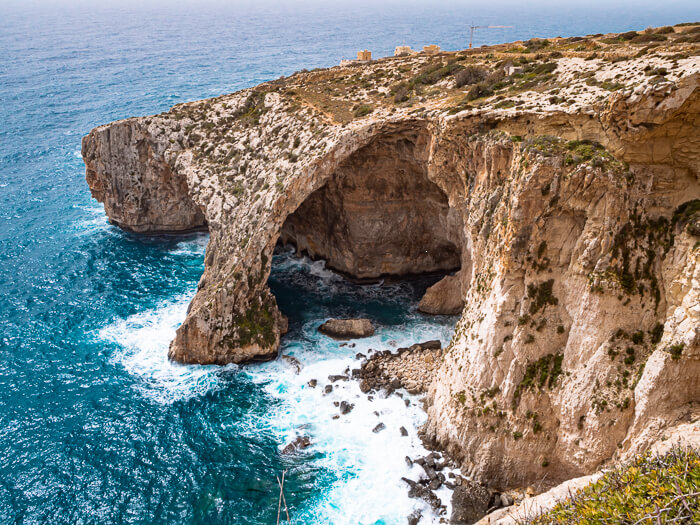
Next, drive to the idyllic fishing village Marsaxlokk. As soon as you arrive at the harbor, you’ll see dozens of colorful traditional Maltese boats, called Luzzu, which the village is known for.
Take a stroll along the beautiful waterfront promenade, have a drink with a harbor view and enjoy the catch of the day in one of the many seafood restaurants. I’ve heard great things about T’Annamari Restaurant but unfortunately it was closed during our visit.
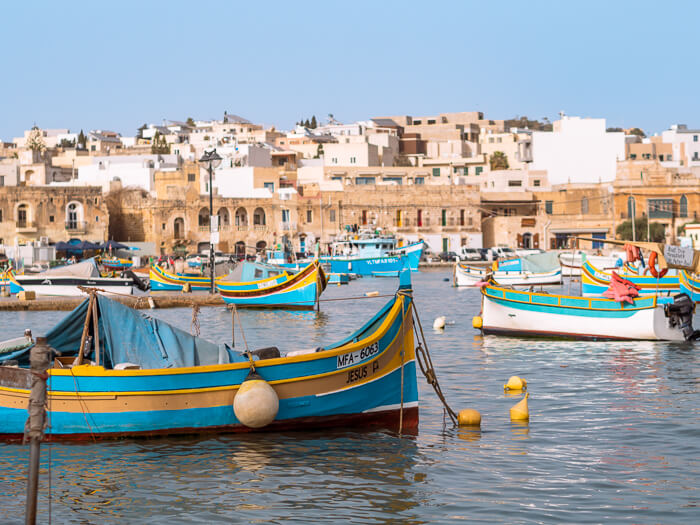
After visiting Marsaxlokk, spend a relaxing afternoon at St Peter’s Pool. This natural pool is a popular spot among the locals who come here to swim, sunbathe and cliff jump.
On a calm day, the water in the cove is crystal clear and bright blue. When we were there though, the sea was very rough. There’s also a hiking trail along the coast where you can discover other secluded coves and viewpoints.
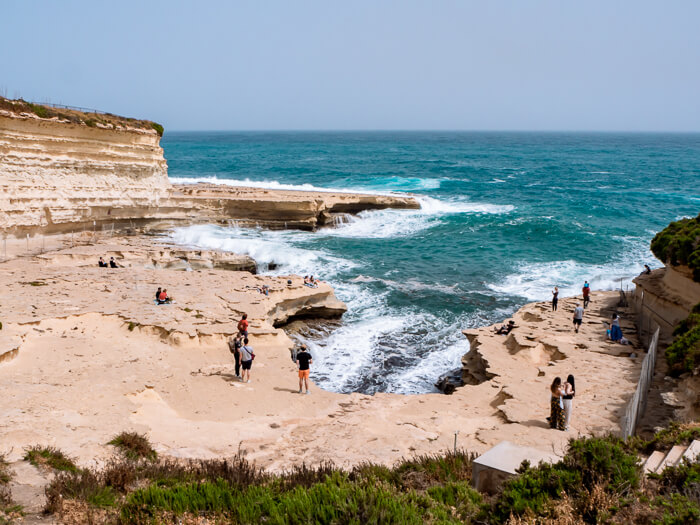
I recommend spending the next three nights in St. Julian’s or Sliema. These areas are just a stone’s throw from Valletta but offer a lot more accommodation options and you’ll have a better chance of finding parking.
MID-RANGE: be.HOTEL This modern 4-star hotel is situated near many shops, bars and restaurants, and boasts an amazing rooftop terrace with a heated pool. A delicious breakfast is included in the room rate as well!
LUXURY: Boutique Hotel Juliani Located on St. Julian’s waterfront, this stylish family-run boutique hotel offers bright and spacious rooms and a rooftop pool with a view over Spinola Bay. They also have a fitness center and a spa.
Related post: 15 best Instagram spots in Malta
Day 3: Mdina, Rabat and Dingli Cliffs
The next stop on this 7-day Malta itinerary is Mdina, also known as The Silent City. This gorgeous fortified town is the former capital of Malta and one of the top attractions in the country.
The best thing to do here is to wander around the winding alleyways, marvel at the impressive Norman and Baroque architecture and take in the town’s medieval charm. The most notable attractions in Mdina are St. Paul’s Cathedral, Mdina Gate, Palazzo Falson and Palazzo Vilhena.
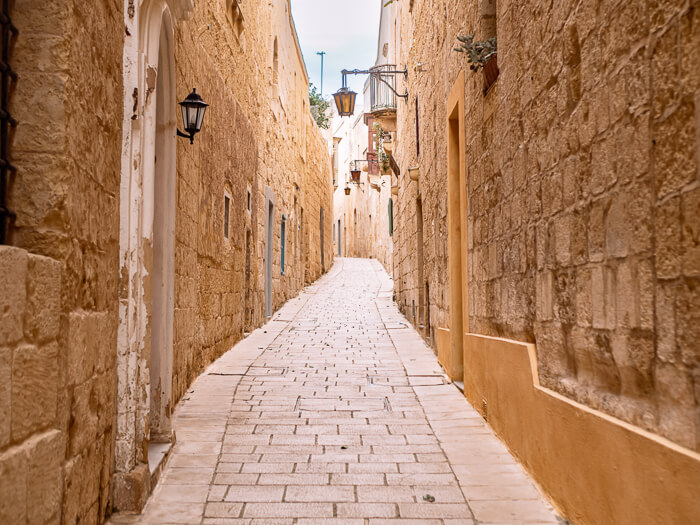
If you’re a fan of Game of Thrones, you’ll probably recognize some spots in Mdina since it was the filming location for “King’s Landing”.
Looking for something to eat? Then pop into Fontanella Tea Garden for some delicious cakes, Maltese specialties and sweeping views of eastern Malta.
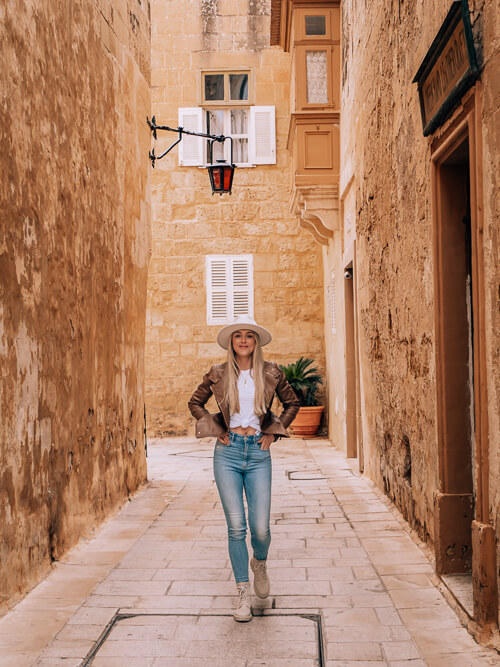
After exploring Mdina, visit the adjacent town Rabat. Take a stroll around its narrow streets, visit some local shops and enjoy the authentic vibe. If you’re into eerie experiences, you might also want to visit the underground tombs of St. Paul’s Catacombs.
Round off your day with a visit to Dingli Cliffs. I didn’t have the chance to visit these cliffs myself but it’s high on my list for the next time I visit Malta! With a height of 250 meters, this place is the highest point in Malta and offers panoramic views of the Mediterranean Sea. It’s also considered one of the best spots for watching the sunset in Malta so you might want to time your visit accordingly.
Spend another night in St. Julian’s, at be.HOTEL or at Boutique Hotel Juliani .
Day 4: Red Tower, Popeye Village and beaches
Continue your Malta road trip by exploring the northern part of the main island.
Start with a quick visit to Saint Agatha’s Tower, also known as the Red Tower. This 17th-century fortified watchtower is painted in bright red color and looks like a small castle.
As it sits on top of a hill, the views from here are pretty amazing and you can even see the islands of Comino and Gozo. Walking around outside the tower is free of charge but if you’d like to enter to learn about its history, you’ll need to pay a couple of euros.
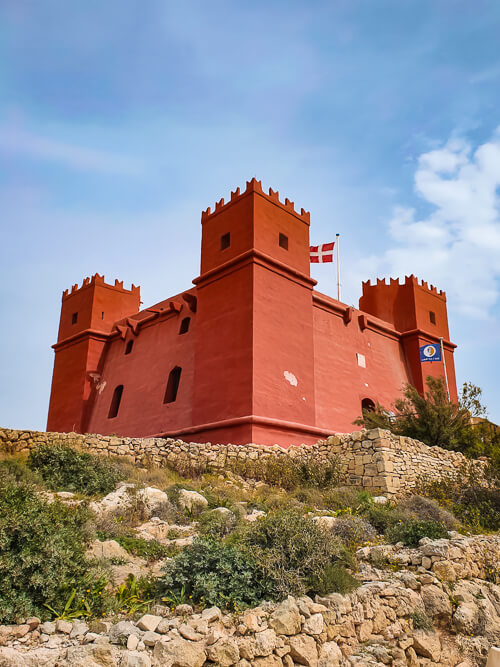
After that, head to Popeye Village . This place served as the film set of the 1980 movie “Popeye” and is now used as a theme park.
Even if you don’t care about Popeye or theme parks, it’s definitely worth making a quick stop at the viewpoint opposite the village. It’s free of charge and you get to see the fantastic turquoise water of Anchor Bay with a backdrop of the quirky village. You might recognize this view from social media since it’s one of the most famous Malta Instagram spots .
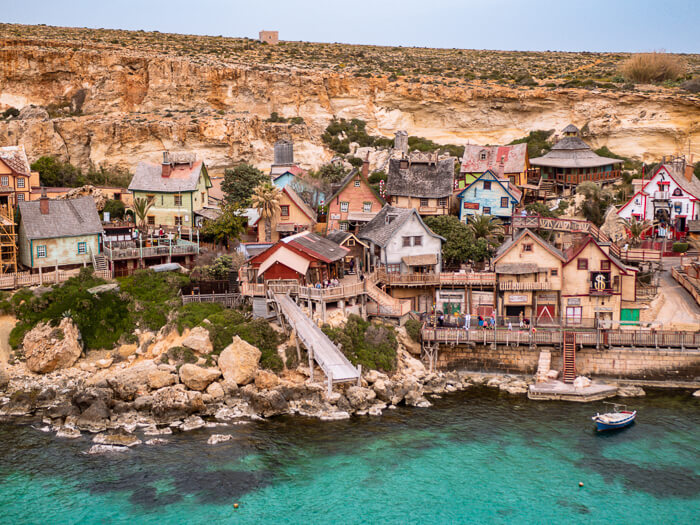
Spend the rest of the afternoon at Ghajn Tuffieha Beach or Golden Bay Beach. These two adjacent beaches are considered some of the best in Malta and feature calm blue water, soft sand and beautiful scenery. Ghajn Tuffieha Bay is less developed and perhaps a little quieter than Golden Bay but you can expect both of them to get quite busy in the summer.
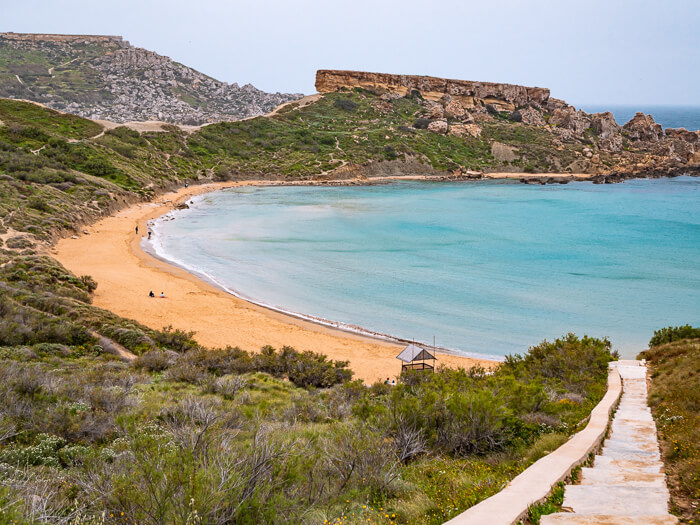
Day 5: Gozo
On Day 5 of this Malta itinerary, head to Gozo, the second-largest island in the Maltese archipelago. Ferries to Gozo depart every 45 minutes from Cirkewwa and the journey takes around 25 minutes. You only have to pay on the way back to the main island.
Although many people visit Gozo on a day trip, I think it’s definitely worth spending a night here because there’s a lot to see.
One of the coolest places in Gozo is the Tal-Mixta Cave. It is situated up in the hills on the eastern coast of the island and offers a spectacular view of Ramla Bay, one of the best beaches in Gozo.
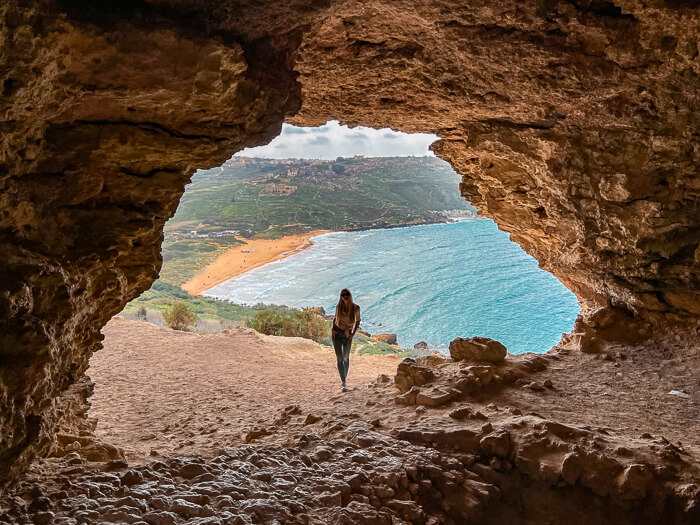
As the cave tends to get pretty crowded, arrive early if you want to have it to yourself and get some nice photos. When you’re done admiring the view, drive down to Ramla Beach to enjoy the beautiful orange sand and crystal clear sea.
Another place you shouldn’t miss is the 350-year-old Xwejni Salt Pans which are still used by the locals to harvest salt. Here you’ll find some interesting rock formations and a chequerboard of salt pans spanning several kilometers along the rugged coast.
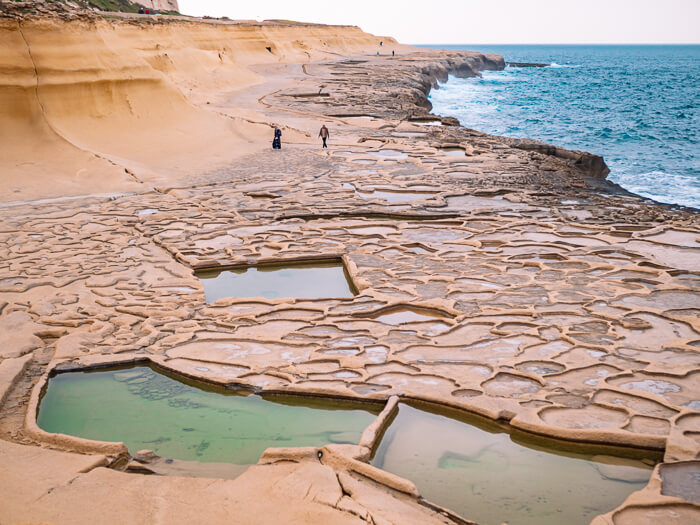
If you have time, visit also the magnificent Ta’ Pinu Church and Inland Sea, a small lagoon surrounded by cliffs and cute fisherman huts. Other interesting spots that I would’ve loved to visit but didn’t have time for are Wied il-Ghasri sea canyon, Wied il-Mielaħ Window and Ta’ Cenc cliffs.
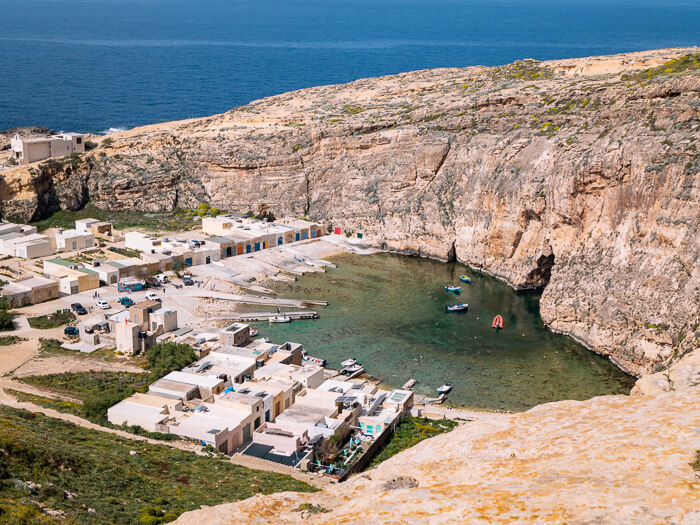
Spend the night in Gozo. I recommend staying in or near Victoria, the capital of the island.
MID-RANGE: Casa Gemelli Boutique Guesthouse Situated in the center of Victoria, this guesthouse features colorful traditionally-decorated rooms, some with a view of the citadel of Victoria. Also, their breakfast is supposed to be exceptional.
MID-RANGE: Quaint Hotel Xewkija We spent one night in this boutique hotel and really loved our stay in the beautiful spacious suite with a jacuzzi. The best part though was the breathtaking view of the Church of Saint John the Baptist from our terrace. Make sure to book a room that faces the square!
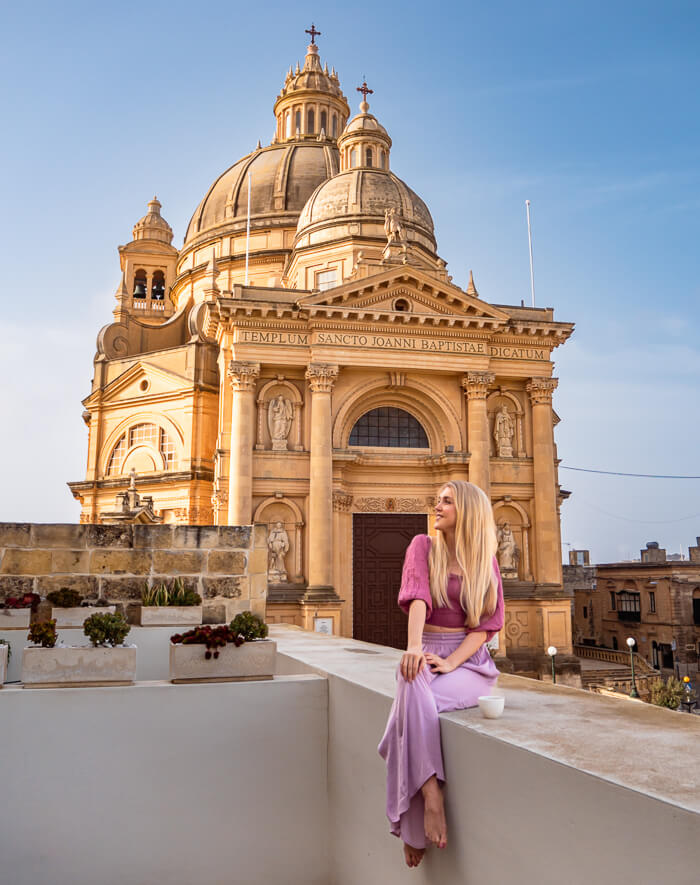
Day 6: Comino and the Blue Lagoon
The sixth day of this Malta itinerary is all about exploring the island of Comino.
This car-free and virtually uninhabited island can be reached by a short boat ride either from Gozo (Mgarr harbor) or from Malta (Cirkewwa harbor). Alternatively, you could opt for a proper guided boat excursion which stops at several points of interest along the coast and you’ll have access to toilets, a cafeteria, a water slide etc.
For a more tranquil experience, you can also charter a private boat with a skipper and discover the treasures of Comino at your own pace.
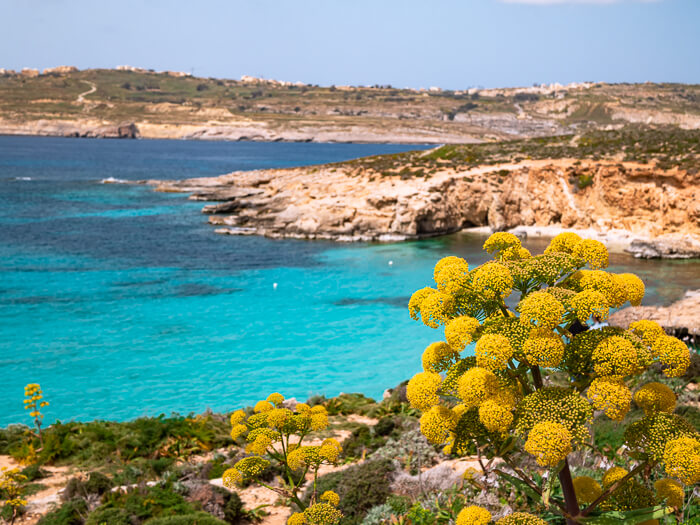
The main reason for visiting Comino is to see the incredible Blue Lagoon. This sheltered cove is a paradise-like place with the most vibrant turquoise water. I was completely awestruck by its beauty when we arrived! I think it’s safe to say that this is some of the bluest water you can find in Europe. (But it might not beat the beaches in Milos Island in Greece!)
Here you can go swimming, snorkeling and sip tropical cocktails served at the beachside bars. Make sure to drop by the Crystal Lagoon as well, which is another amazing spot with dazzling water but fewer crowds. You can also walk around the island to visit the Saint Mary’s Tower, Santa Marija Bay and San Niklaw Bay.
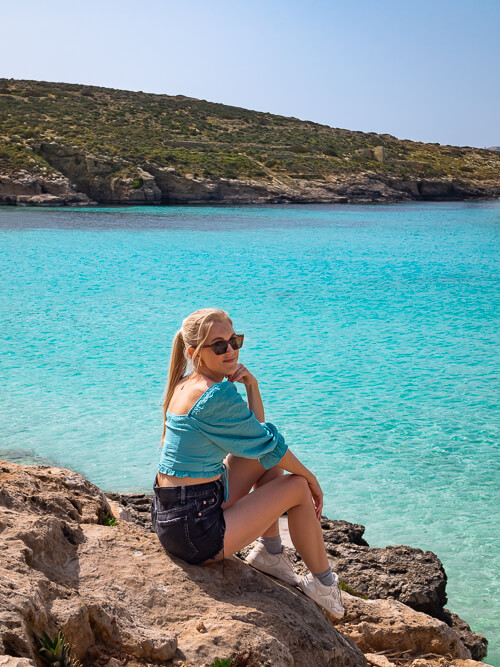
In the summer season, the Blue Lagoon gets extremely busy so it’s best to arrive early. Despite its popularity, seeing the Blue Lagoon was the absolute highlight of my 7 days in Malta. It’s a place you simply can’t miss when you’re visiting Malta!
Return to the main island of Malta and spend the night in Mellieha.
MID-RANGE: Solana Hotel & Spa We spent one night in this stylish 4-star hotel. They have newly renovated rooms, two restaurants, a spa with a heated pool and also a rooftop pool overlooking the city.
Day 7: Mellieha
Wrap up your week in Malta with a relaxing day at Mellieha.
This little resort town is home to Ghadira Bay, the largest sandy beach in Malta. Spend your day sunbathing on its soft sands and swimming in the shallow crystalline water. You can rent sunbeds and umbrellas and there’s a handful of cafes along the beach as well.
If lounging on the beach all day is not your cup of tea, you can choose from a variety of water activities at Ghadira Bay such as windsurfing, kite surfing, water skiing, SUP, snorkeling and kayaking.
7-day Malta itinerary map
On this map, you can find the locations of all the stops included in this 7-day Malta itinerary. Click on the top left corner of the map for more details.
Have more than a week in Malta?
If you have more than a week in Malta, you can discover some hidden gems and get to know the island’s history on an even deeper level.
Those interested in archaeological sites should visit the UNESCO-listed Hal Saflieni Hypogeum, Hagar Qim Temple and the Ggantija Temples, which are older than the Egyptian pyramids.
If you’d like to take a walk through beautiful lush nature, add the Buskett Gardens, San Anton Gardens or Palazzo Parisio to your Malta itinerary. And if you’re up for seeing some more fabulous beaches, consider visiting Paradise Bay, Armier Bay Beach, Pretty Beach and Qawra Point Beach.
Malta is also well connected to the island of Sicily with ferry crossings several times a week. The journey takes between 1.5 hours and 3 hours depending on the route you take. Have a look at my Sicily itinerary to get inspired!
Malta itinerary: Final thoughts
This was my recommended Malta itinerary for 7 days! As you can see, there’s no shortage of amazing places to explore on this little Mediterranean island and even in a short amount of time you can experience a lot.
If you have any questions about the itinerary or recommendations on other places to visit in Malta, let me know in the comments.
Thinking about visiting other destinations in the Mediterranean region as well? Then take a look at my following travel guides:
- Milos Island, Greece
- Antiparos Island, Greece
- Mallorca itinerary
- 7-day Sicily itinerary
- Most beautiful places in Slovenia
- 7-day itinerary for Algarve, Portugal
Enjoyed reading this Malta itinerary? Pin it!
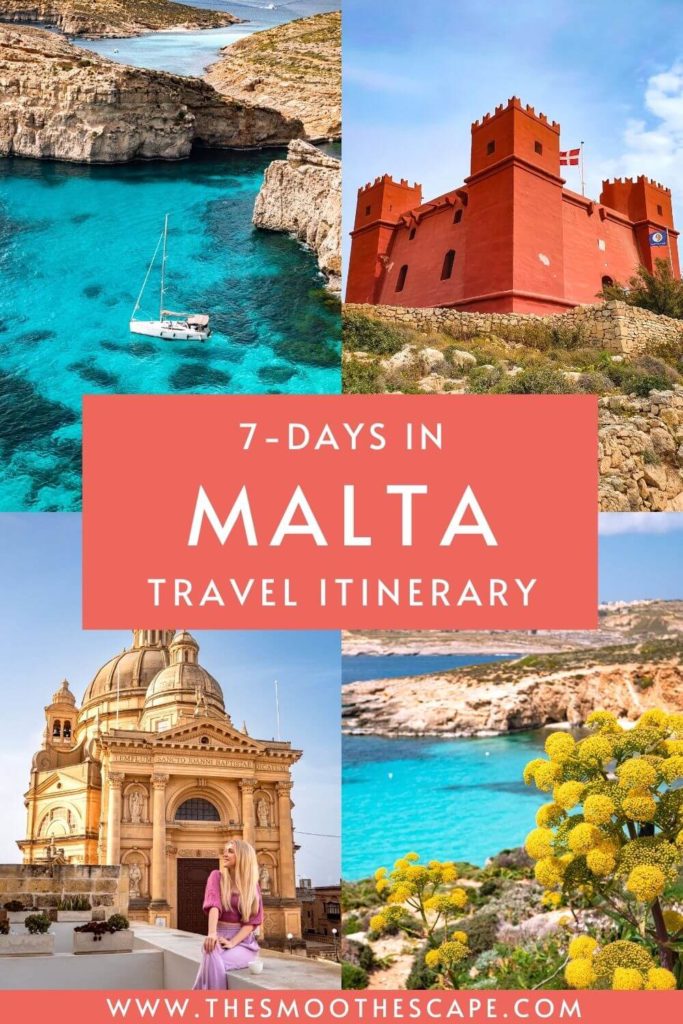
15 amazing Malta Instagram spots (and How to get there)
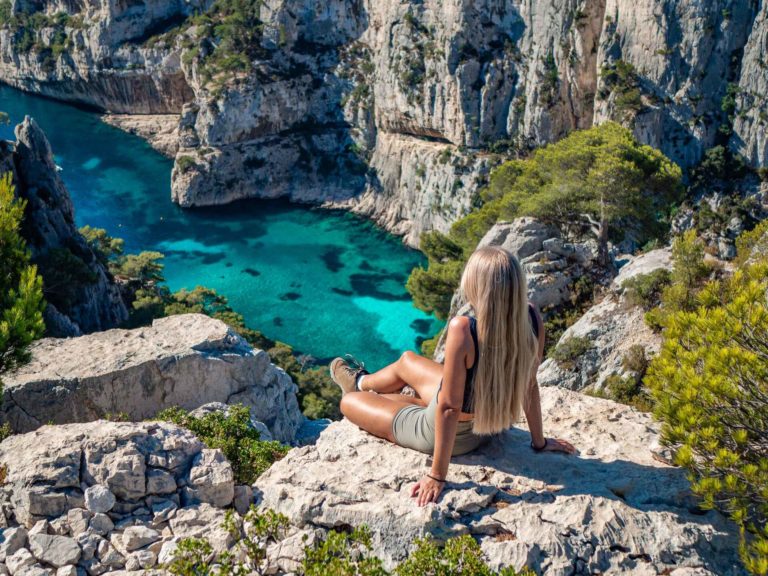
5-day South of France itinerary: Provence road trip for nature lovers
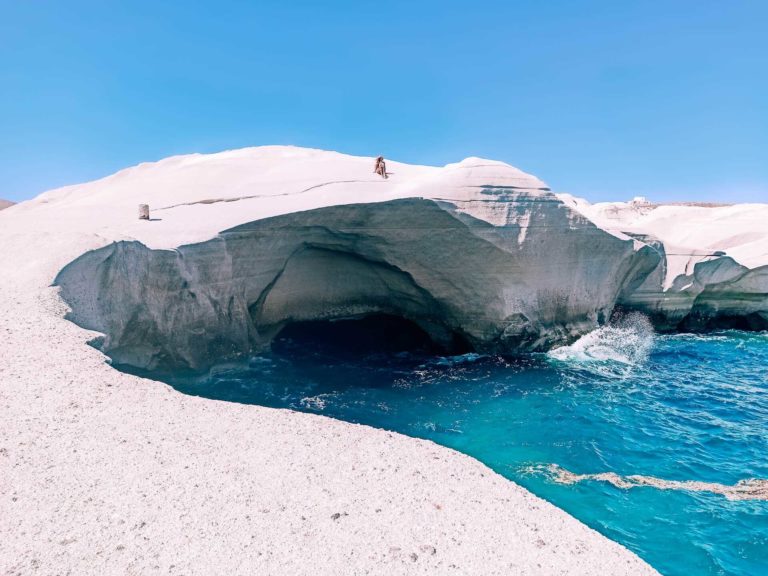
Amazing things to do in Milos, Greece: Beaches, villages and epic views
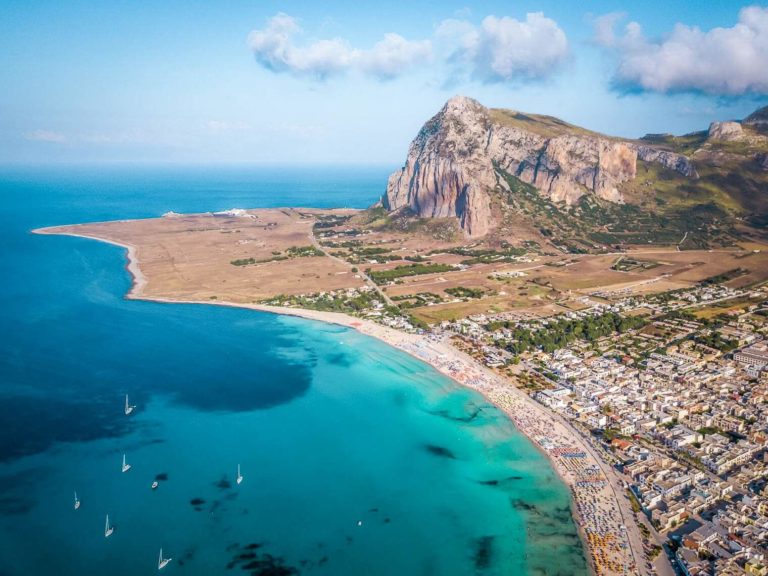
One week in Sicily: The perfect Sicily itinerary
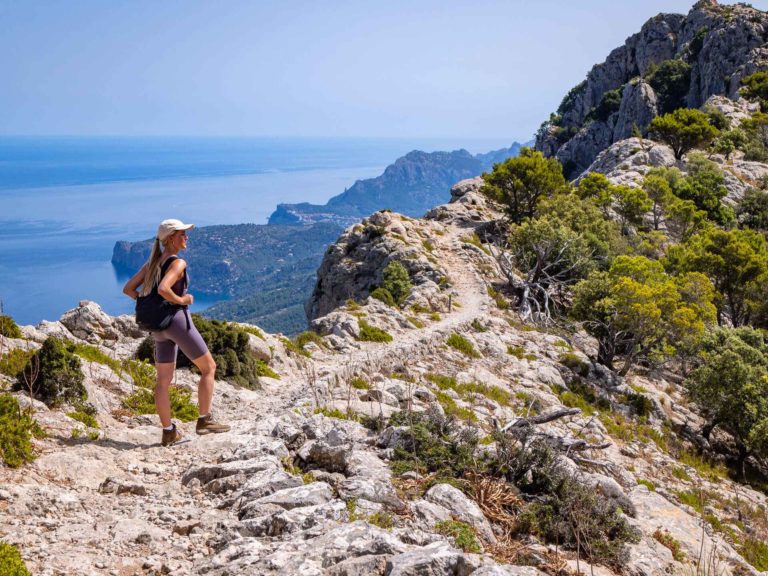
The perfect Mallorca itinerary: An unforgettable week in Mallorca
Hi! Thanks so much for this. I will be going solo as a female and thinking of staying in Valetta the whole time and doing day excursions. Do you think this is ok – that I can get to all these places even without the car? Thanks so much!!
Hi Mary! You’re welcome! 🙂 You will be able to visit the vast majority of these places without a car but it will take you longer time to get from one place to another. Probably the easiest way for you would be to take the hop-on-hop-off bus that I suggested in the article. In Gozo it might be a bit more difficult to get around by buses since the island is less developed but you can always hire a cab there.
Leave a Reply Cancel reply
Your email address will not be published. Required fields are marked *

18 Must-Know Malta Travel Tips for First-Time Visitors
I’d like to officially declare Malta, a beautiful Mediterranean island , as visit-worthy . From the unique vibe of Europe meets the Middle East to the food to the views, Malta is not like any other destination I had visited.
To help you make the most of your time in this gorgeous country and plan your itinerary, here are some essential Malta travel tips.
* This post may contain affiliate links from which I earn a commission (for more info, read my disclosure ). As an Amazon Associate, I earn from qualifying purchases.
* I try to keep the information on this blog as updated as possible, but I still recommend consulting the latest prices, opening hours, and other details on the official website of each site, hotel, and tour, as well as checking the updated public transport routes and timetables.
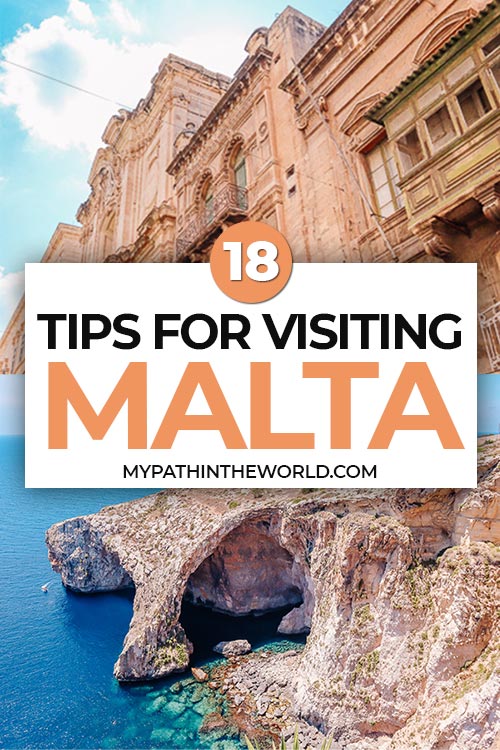
Table of Contents
A Few Things to Know about Malta
- Capital city: Valletta.
- Geographic size: 121 square miles, 316 km².
- Population: Over 440,000.
- Language: Maltese.
- Religion: Roman Catholic.
- Currency: Euro (bring some cash and your credit cards).
Essential Malta Travel Tips
Where to stay in malta.
When choosing where to stay on this island, it all comes down to what you’re planning to do on your vacation in Malta.
If all you seek is to relax and soak up some sun (which is totally legit) consider staying in a town like Mellieha in the northwest of the island (where Malta’s biggest sandy beach is).
If you want to travel around Malta (which I highly recommend), both Sliema and Valletta (the capital) are lively cities from which you can take day trips.
They are well-connected to other parts of the island by public transport, so many travelers base themselves in one of these two locations.
To see all of your options and understand the pros and cons of each area, you can also read my full Malta accommodation guide or my guide to where to stay without a car .
I stayed at Slimiza Suites in Sliema (unfortunately, its rating dropped recently) . Higher-rated options in Sliema include Marea Boutique Hotels , Seafront Duplex Penthouse , and Amery House .
If you prefer to base yourself in the landmark-packed capital, Valletta, check out hotels like Tano’s Boutique Guesthouse , Ursulino Valletta , or 66 Saint Paul’s & Spa .
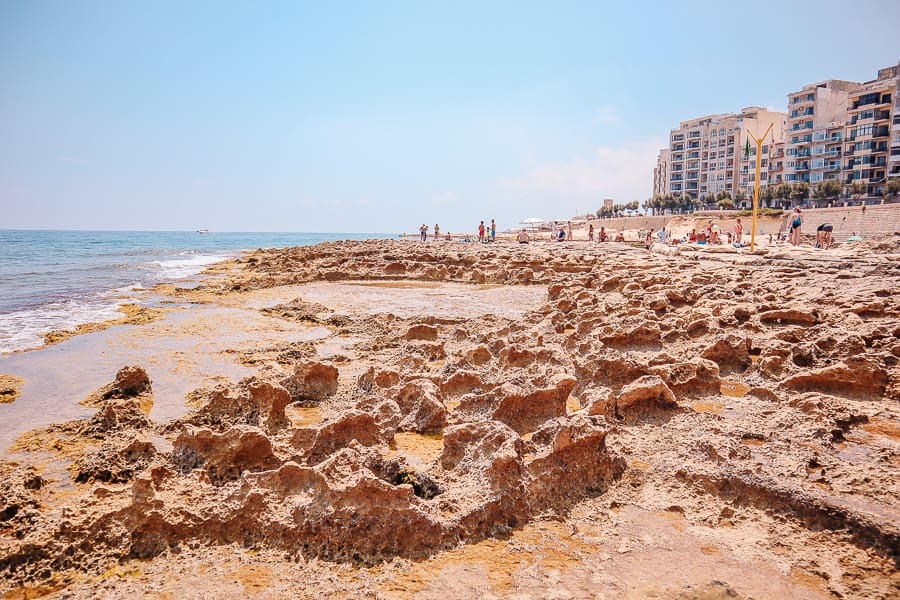
Visiting Gozo and Comino
We can’t talk about visiting Malta without mentioning its two other islands, Gozo and Comino.
While the uninhabited Comino is famous for the Blue Lagoon, some of Gozo’s popular attractions are the Citadel in Victoria, the salt pans, Dwerja Bay, and Ramla Bay.
There are a few ways to visit these islands:
– Cruises and boat trips from Sliema – you’ll see plenty of signs in the ferry area promoting these cruises (and don’t forget to use these helpful cruise apps if you choose to take one) . You can also book tours like this one online.
– The Gozo Fast Ferry from Valletta.
– Full-day tours from Valletta, Sliema, and St. Julians.
– Boat tours and cruises from the northwestern part of Malta, usually from the area of Bugibba ( you can compare all itineraries and prices here ).
– Take a bus to Cirkewwa (bus 222 from Sliema or bus 41 from Valletta) and take the ferry from Cirkewwa to either Gozo or Comino. When getting to Gozo, you can explore it by car, taxi, bus, or sightseeing bus .
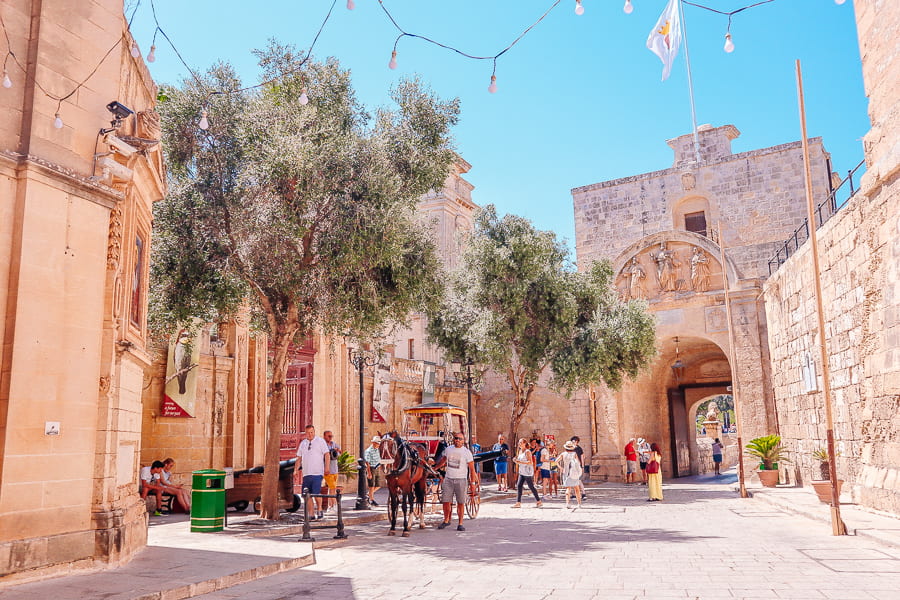
When to Visit Malta
Ideally, you’ll want to travel to Malta in mid or late spring, early summer, and early or mid-fall to enjoy the best weather and avoid the crowds of the summer months (though Malta is now a lot more popular not only in July and August).
If your only options are July and August, choose July when the temperatures are still quite bearable, but visiting Malta in April , May, June, September, and even October is better (but take some possibly cloudy and rainy days into consideration).
With the hot weather during these months, some of the most important things to pack for Malta and Gozo (and Comino) include sunscreen and a reusable water bottle that will actually keep your water cool (I love Corkcicle’s canteen ).
Keep in mind that though it has become safe to drink tap water in Malta, you might not like the taste or still want to use a bottle with a filter.
If you love chasing the winter sun in Europe , you should also consider Malta for an off-season trip. You will definitely see much fewer tourists and pay a lot less per day for accommodation.


Traffic Is an Issue
No matter how you choose to get around Malta, be prepared for a lot of traffic. And more traffic. And some more traffic. This is a known issue in Malta and one of the reasons I didn’t want to drive there.
Although you shouldn’t panic too much about it (because there’s nothing you can do to change it), it is something to think about when planning your Malta itinerary .
Getting from one point to another will take longer than it should, and you should just be aware of that.
Getting Around Malta by Car
Sometimes there’s nothing like a good old road trip. You have utter freedom and flexibility to go wherever and whenever you want. Yet in Malta, there are a few things to consider before deciding to get around the island by car.
Beyond the traffic issue, you need to be okay with driving on the left side of the road and driving alongside Maltese drivers (which requires some courage).
If you haven’t taken a Europe an road trip yet, I personally think you should save it for another country like Spain or Portugal .
If you do want to hire a car in Malta, you can compare different car rental deal prices here.
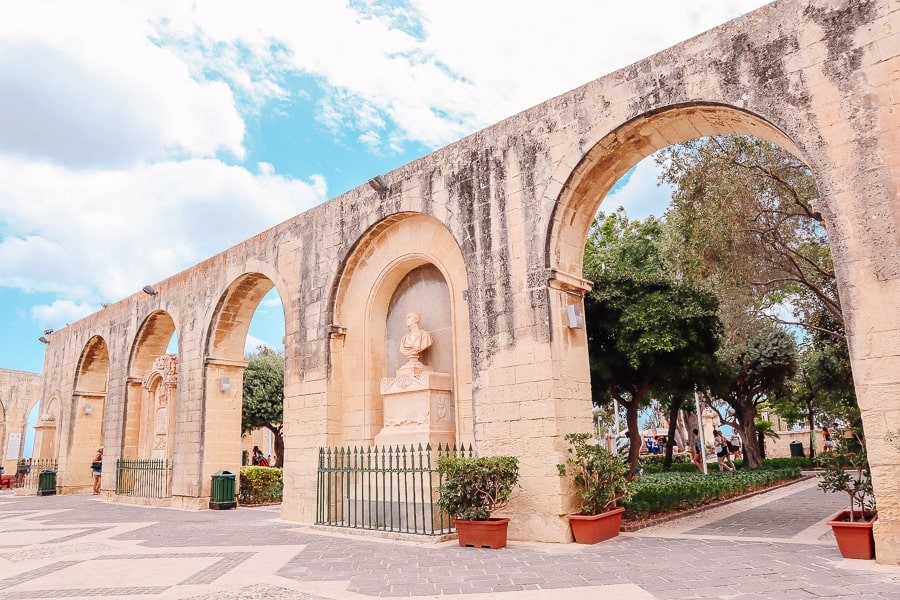
Getting Around Malta by Bus
Even though Malta’s bus system is not perfect, getting around by bus is one of your best options. Here are a few things you should know.
1. Good Things About Buses in Malta
– The buses themselves are clean and air-conditioned.
– You can buy your ticket directly from the driver (unlike many big European cities in which you need to buy it in advance and the bus driver won’t even look at you). This single-journey ticket is valid for 2 hours, including transfers.
– In both Sliema and Valletta, you can buy a 12-ride card at the ticket office or machines next to the bus terminal (see all sales points here ). If you want to save money, this is a great way.
2. Annoying Things About Buses in Malta
– There are too many people and not enough buses. It means that if you’re not one of the first people to go on the bus, you might have to wait for the next one.
– The most popular places to visit in Malta are not all directly connected by public transportation. Depending on your itinerary, there’s a chance you’ll need to switch buses and take a longer route to travel between two places that are fairly close to each other.
– Buses’ timetables can be unexpected, so be sure to consult them on the website of Malta’s public transportation .
Overall, I think everyone should use public transportation when visiting a new destination at least once. It lets you experience the everyday life of the locals and allows you to see things from a different angle.
It can also lead you to places you wouldn’t have seen otherwise, which is exactly why I enjoyed my bus rides in Malta so much. We went into towns and streets I probably wouldn’t have visited, and I got to enjoy some pretty charming views.
There’s also the option of getting around Malta by a hop-on-hop-off bus , but I haven’t tried it myself.
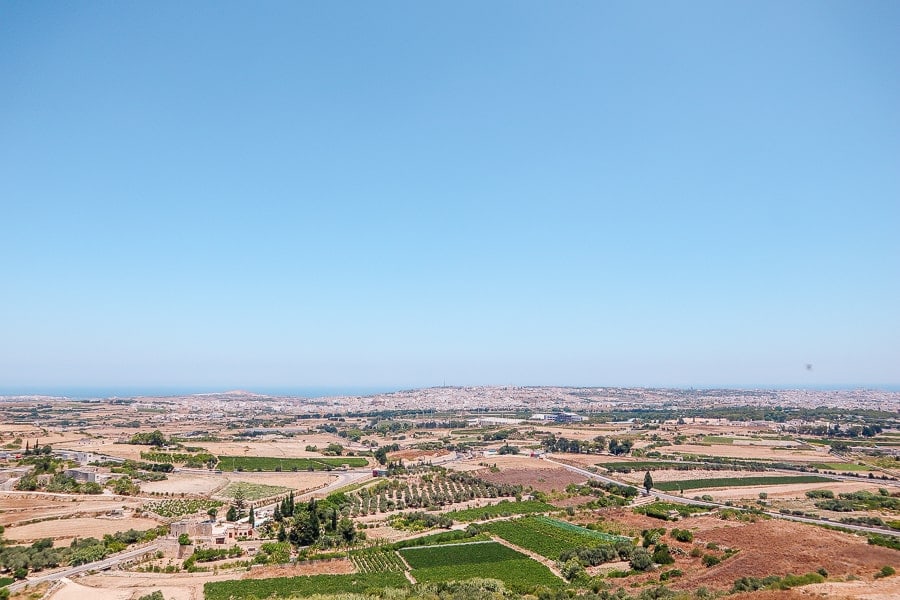
Getting Around Malta by Ferry
From Sliema to Valletta (and vice versa) and from Valletta to the Three Cities, you can (and should) take a ferry instead of a bus since it only takes about 5 minutes to get from one point to another.
The ferries leave once every half an hour, and you can buy a round-trip ticket which is slightly cheaper than two one-way tickets.
Getting Around Malta by Taxi
Sometimes saving time is more important to me than saving money on my travels.
While taxis in Malta are not nearly as cheap as buses, I have used them a few times when I didn’t want to take two or more buses (and travel for 90 minutes instead of 15) to get from one place to another.
If you don’t mind spending a bit more money to save a few hours on the road (and possibly a headache), taxis are a valid option.
Tip #1: You can negotiate the price and lower it by a few euros.
Tip #2: If possible, look for a taxi station instead of catching one on the street.
Tip #2: You can also use Uber or Malta’s eCabs app.

Get Ready for an Interesting Mix of Cultures
I was excited to visit Malta and get to know its culture because it seemed like such a unique European destination.
Throughout the years, Malta was ruled by the Romans, Arabs, Knights Hospitaller , and Brits, to name a few, and it’s located near Sicily and northern Africa, so you can feel the mix of cultures in everything and everywhere.
Maltese sounds like a combination of Italian and Arab, the food will remind you of Italy , the cities look Middle Eastern, the churches look Roman and Greek, they drive on the left side, and red phone booths are scattered around (mostly in Valletta).
Combine all of these cultural bits and pieces, and you’ve got yourself an explosion of uniqueness.
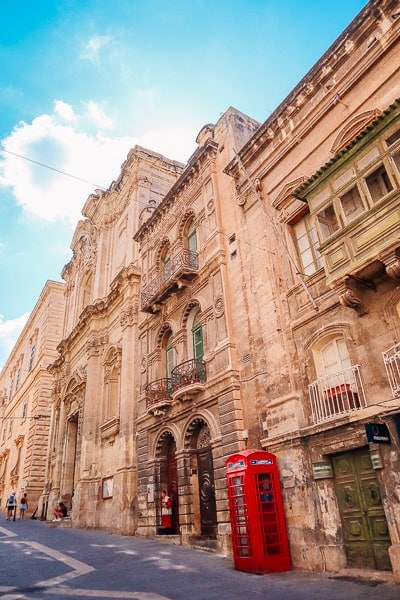
English Is the Second Official Language
Driving on the left side of the road is not the only influence of 150 years of British rule.
You’ll be happy to know that the majority of the locals speak decent English (especially in tourist areas like Valletta) since it is another official language in Malta.
A language barrier can be frustrating to deal with when traveling, so that’s one less thing to worry about in Malta.
The Atmosphere Is (Very) Laid Back
The Maltese lifestyle is relaxed and laid-back, which can be positively contagious if you want to learn how to take things easier (who doesn’t?).
On the other hand, it also means that some things like getting your food at a restaurant can take a little longer than what you’re used to, so be patient.
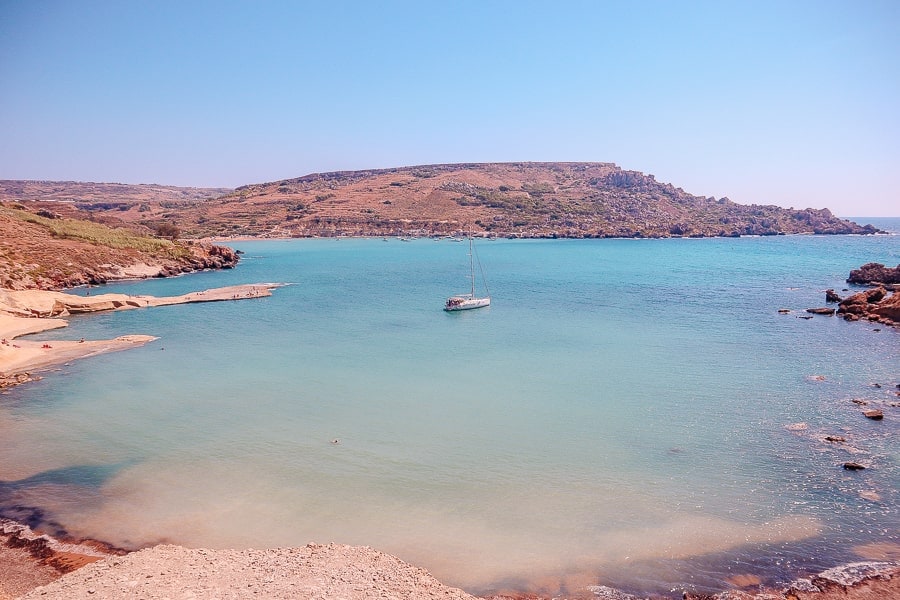
Plug Type Used in Malta
Malta uses plugs of type G (yet another British influence) and operates on a 230V supply voltage and 50Hz.
You can consult your country’s plug type and voltage here to see if you need to pack a power adapter and a voltage converter .
My hotel also provided power sockets that worked with plugs C, E, and F, but it’s best to have an adapter with you.
You Never Know Where You’ll Find a Place to Get in the Water
Some beaches in Malta are sandy, many are rocky, and others are not even beaches. In fact, one of my favorite things about Malta is that you might find a pool ladder to help you get into the beautiful water where you least expect it.
Whether it’s in Sliema’s Roman baths, near the famous Blue Grotto, or swimming areas like the natural St. Peter’s Pool , you should always have your bathing suit with you, and you should always be prepared to take a dip.
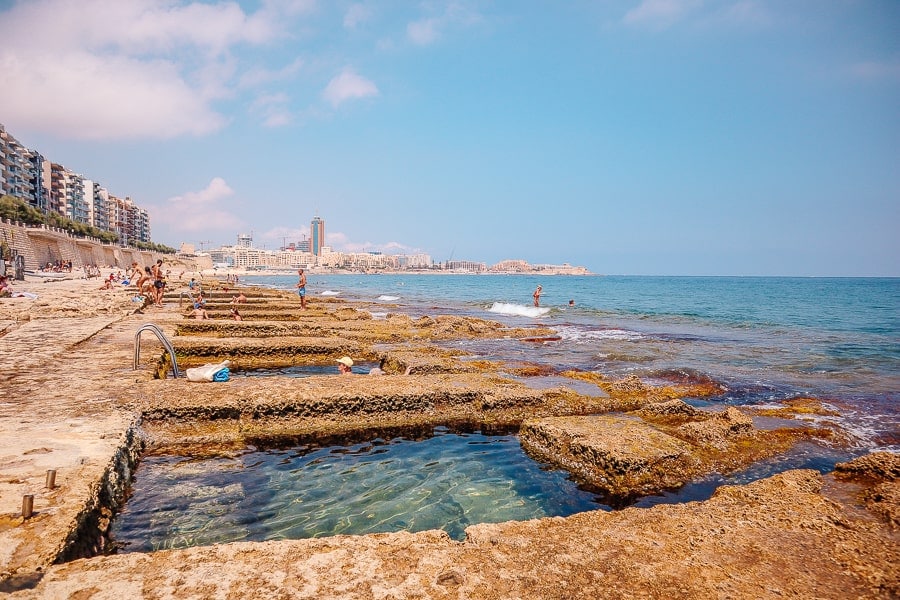
It’s Not Just About Beaches
I have much respect for Malta’s beaches because they are seriously gorgeous, but there’s SO much more to this island.
From fishing villages and UNESCO cities like Valletta and Mdina to archeological sites and cave boat tours to quirky attractions like the Popeye Village, Malta is a lot more diverse than people think.
Malta Is Small, but There’s a Lot to See
As I’ve just mentioned, there’s quite a lot to do and see in Malta, so even though the island is small, don’t let it fool you.
Malta deserves at least 4 to 5 whole days, and a week or 10 days would be even better to see its hidden nooks and crannies.
Taking into consideration the fact that getting around from one spot to another does take some time, you also don’t want to add too many places to your daily itinerary.
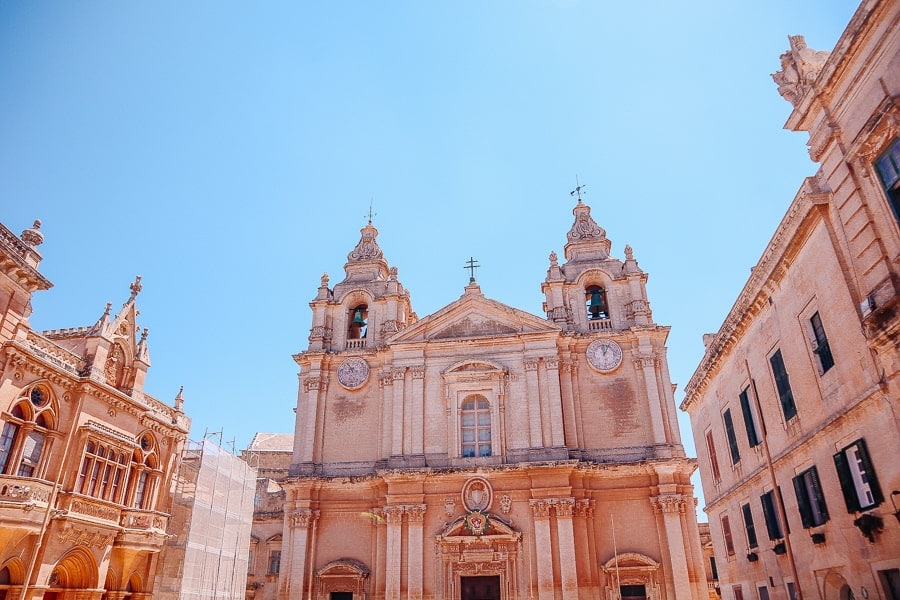
Attend Some Festas
Did you know that there are more than 350 churches in Malta? Each one is dedicated to a different saint, and each saint gets its own celebration!
Instead of having almost a full year of celebrations (which sounds awesome), many of these festivals take place during summer, and they include decorated streets, fireworks, band marches, and more.
For more information and tips for visiting Malta’s festas, read here .
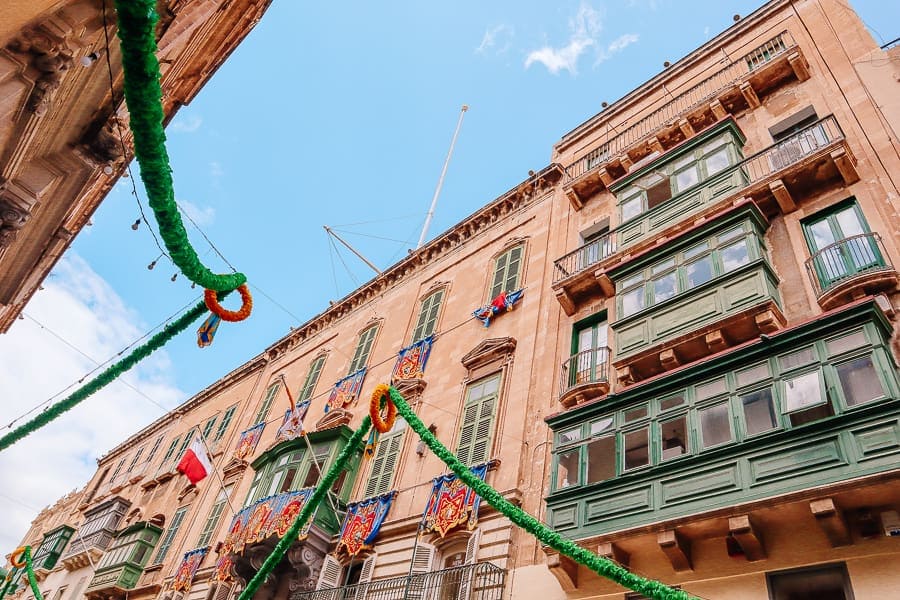
Pastizzi Are the Definition of Happiness
Oh, pastizzi , you wonderful flaky pastries.
If you want to experience true joy, one of my top Malta tips would be to try some pastizzi.
These phyllo-like pastries are usually filled with ricotta cheese or peas, but there are a few other fillings you can try, and some places even serve sweet pastizzi.
When they’re freshly baked and you bite into them while they’re still warm, you get a taste of what I can only describe as heaven.
You’ll see street vendors selling these drops of happiness or find them in special bakeries called pastizzerias or cafes around Malta.
All Three Islands Are a Paradise for Divers and Snorkelers
From diving in Gozo ‘s Blue Hole and Comino’s Crystal Lagoon to snorkeling in Malta’s St. Peter’s Pool, all three islands provide more than enough places to take an adventurous dip.
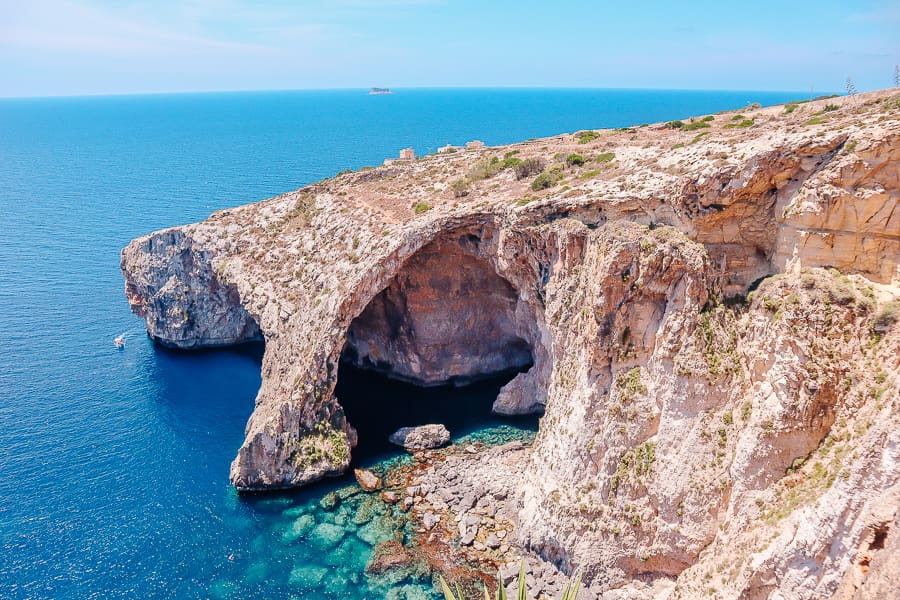
Consider Malta for your next girls’ trip in Europe !
Did you find my Malta travel guide helpful? Pin this post for later using the share icon on the right bottom corner!
About Or Amir
Hey, I'm Or! I'm a passionate traveler with a severe coffee, chocolate, and pastry addiction (or any other carb for that matter). I'm always planning my next trip to Spain, Italy, or any other country in Europe, and my goal is to help you make the most of each destination.
2 thoughts on “18 Must-Know Malta Travel Tips for First-Time Visitors”
I enjoyed reading this guide, thanks for sharing. I visited Malta a couple years back but I wish I spent more time on Gozo rather than just a day trip. I also found the waters around Malta had a lot of jellyfish, it might’ve been to do with the time of the year I was there (July).
Thank you! Slow travel is always better, so I also hope to go back to spend more time in Gozo. I also visited in July and didn’t come across any jellyfish, so I guess it depends on the area you explore.
*Your emil address will not be published. By using this form you agree with the storage and handling of your data by this website
Leave a Comment Cancel reply
Save my name, email, and website in this browser for the next time I comment.
Hi, I'm Or!
I'm a passionate traveler obsessed with traveling in Europe and discovering hidden gems in each place I visit. For me, it's not about ticking destinations off the bucket list but experiencing each one of them to the fullest. Read more about me and my story.

Grumpy Camel
Slow travel & blogging, welcome to my malta travel guide.
Here, you’ll find everything you need to know about visiting the island.
As a local, I share my top suggestions for things to do, places to stay, food to try, and more.
So, let’s dive right in!
Things to know about Malta
- It's a bilingual country. Most people speak English.
- Summers are really hot! The best time to visit Malta is between September and May.
- We drive on the left.
- We have a lot of public holidays and celebrations.
- Malta is one of the most densely populated countries in the world, so expect a lot of noise and traffic.
- Food portions are huge!
Related Posts

10 Things to Know Before Visiting Malta

When is the Best Time to Visit Malta? A Local’s Advice

20+ Insider Tips for Visiting Malta
Where to stay in malta.
for the nightlife and cafe scene
for the culture, history, and wine bars
for a quiet, romantic holiday
for the beaches and restaurants
for an authentic experience
Recommended hotels in Malta
Julina Boutique Living : a boutique hotel in the heart of Mosta with lush, Baroque-style decor, and a sun terrace.
Palazzo Bettina : a boutique hotel In Birgu, housed in a beautifully renovated 17-century palace.
Soleil B&B : an adults-only B&B in Gozo, housed in a traditional building with a swimming pool.
Adelphi Boutique Hotel : a beautiful hotel located on a quaint street in Rabat, with a restaurant that serves traditional Maltese food.
Provicario : this B&B is housed in an old building in Victoria (Gozo), and offers stunning view of the citadel.
Casa Ricca : a family-run guesthouse in a restored palazzino in St. Paul’s Bay, with beautifully decorated rooms and a nice garden.
Things to do in Malta
- Spend a day in Valletta
- Visit Mdina at night
- Enjoy a traditional meal in Mgarr
- Go for a swim at Golden Bay
- Visit the Hypogeum
- Tour the megalithic temples
- Take a day trip to Gozo
- Go hiking in Dingli
- Explore the old city of Birgu
Beautiful beaches
- Paradise Bay
- Ghadira Bay
Historical sites
- Fort St. Angelo
- St. John's Cathedral
- St. Paul's Catacombs
What to eat in Malta
a savoury pastry filled with ricotta or mushy peas

typically cooked in red wine and garlic, and served with potatoes

calamari, octopus, lampuki, tuna, and other local fish

Honey rings
kannoli, imqaret, helwa tat-tork, and other Maltese sweets

What to pack for Malta
- Pest repeller for mosquitos
- Good walking shoes for Malta's uneven pavements
- Stainless steel water bottle to stay hydrated
- Microfibre sand-free beach towels
- Polarised sunglasses for the unrelening sun
- SPF sunscreen
More Malta travel guides & tips

One Week in Malta: A Complete Itinerary

Driving in Malta: A Survival Guide for Tourists

Malta in October: A Complete Guide

Visiting Malta in December (A Complete Guide)

Staying at Palazzo Bettina in Birgu

Where to Stay in Malta: Best Areas & Hotels

Amazing Malta Tours (& Gozo Day Trips) You Cannot Miss

Mdina & Rabat Guide: Best Things to Do & Places to See
This page contains affiliate links. This means that I may receive a commission on any purchases made through the links in the post at no extra cost to you.
© Grumpy Camel 2024. All rights reserved.
Privacy Overview

The Perfect 7-Day Malta Itinerary
Last Updated on January 15, 2024
by Maggie Turansky
Disclaimer: This article contains affiliate links. That means if you click a link and make a purchase, we may make a small commission. As an Amazon Associate we earn from qualifying purchases. For more information, see our privacy policy.

Though the island nation is incredibly small in size, planning out the perfect Malta itinerary can be a bit of a difficult task when considering all of the amazing things to do in this beautiful Mediterranean country.
While Malta may seem small (it is!), that doesn’t mean that it lacks amazing things to do and see and travellers could easily fill over two weeks on the Maltese archipelago and not get bored. If you don’t have an endless amount of time to devote to your trip, however, you can do and see quite a bit in just one week.
If you’re wondering where to go in Malta in one week, make sure to follow this itinerary in order to have the best trip to Malta possible!
Table of Contents
How Many Days in Malta?
It’s true, Malta is small, but don’t let this fool you into thinking that there isn’t much to see or do. The truth of it is actually quite the contrary and it is why many potential visitors wonder how many days to spend in Malta.
While you can cover a lot of ground in a short stretch of time, I wouldn’t recommend spending less than one week if you genuinely want to get the most out of your Malta trip.
Spending a full 7 days in Malta will allow you to explore its lovely cities and visit the myriad historical and UNESCO World Heritage Sites while also giving you enough time to relax in the Mediterranean sunshine and experience the stunning coastline with its crystal clear waters.

Getting To & Around Malta
As a Mediterranean island nation, the most likely (and straightforward) way to get to Malta is by plane. The Malta airport is located about 20 minutes from the capital of Malta, Valletta, and they serve a number of airlines across countless destinations both in Europe and internationally. It is possible to book a private airport transfer here.
You can also reach Malta by ferry from nearby Sicily with regular routes from cities like Catania or Palermo .
Once in the country, it’s easy enough to get around Malta using the extensive bus and ferry system, however, it may be tricky to organise if you happen to be staying on Gozo or outside of Sliema or Valletta on the main island of Malta where there are fewer connections. There are lots of areas to stay in Malta where it may be more practical to have your own vehicle.
If you want a lot of flexibility and ease of getting around, then consider renting a car. There are lots of car hire options in Malta and it’s a great way to see the country! You can browse car hire options here.
For those who do not want to bother with getting around independently, you can easily get to many places in Malta via organised day tours such as to Gozo. This, however, will end up being the most expensive option out there.
7 Days in Malta Itinerary
Day 1 – sliema.
Malta’s largest city of Sliema is the perfect place to base yourself on the island. A stone’s throw away from the historical capital of Malta, Valletta, Sliema is also incredibly well connected in terms of public transport with most buses passing through the city.
But while it seems like more and more people are basing themselves here, fewer people are really taking the time to get to know it. That is why I recommend spending the first day of your seven-day Malta itinerary in Sliema.
There are a number of things to do in Sliema and it’s a great place to get your bearings and really start enjoying your Malta holiday. Begin by having breakfast and a coffee at one of the trendy cafes that the city boasts. Take a couple of hours to have a leisurely stroll along Sliema’s seafront promenade, maybe taking the time to swim in the harbour.
As the sun begins to set, take advantage of a happy hour deal and enjoy a drink at a seaside cafe. End your day with a great local meal at Ta’Kris , one of the best restaurants in Sliema.
Where to Stay in Sliema
Mr Todd Hotel – This small hotel is located in the heart of Sliema and only a stone’s throw from the swimming areas that line the promenade. They have a number of clean and comfortable rooms on offer, 24-hour check-in, and a free breakfast included in the room rate.
Quisisana Apartments – If you’re looking for a different sort of accommodation, then these centrally located apartments can be a great choice. Centrally located in Sliema, they have a range of flats on offer that are all fully furnished with everything you may need.
Two Pillows Hostel — If you’re travelling solo or on a budget, then you can’t go wrong with this boutique hostel. The first hostel in Malta, this place offers clean and comfortable rooms (both dorm and private), a great location in Sliema, and a friendly and helpful staff.
Not quite what you’re looking for? Click here to browse other hotels in Sliema!

Day 2 – Valletta and the Three Cities
On the second day of your one week in Malta trip, it’s time to explore the lovely Maltese capital city of Valletta . A UNESCO World Heritage Site, this diminutive city is very much on the up and up as tourism goes and is one of the places to visit in Malta that you cannot miss.
I’d recommend trying to get an early ferry (they leave every thirty minutes from the Sliema terminal) to beat the crowds and the heat that can accumulate later in the day.
Walk along the city walls to the Upper and Lower Barrakka Gardens and enjoy the stunning views of the Mediterranean Sea, the Grand Harbour and the Three Cities and take the time to visit St. John’s Co-Cathedral and marvel at its impressive facades and collection of paintings by Caravaggio.
Pop in for lunch at Submarine, where you can get a fresh, made-to-order sandwich for a good price before catching the ferry to the Three Cities.
Spend your afternoon exploring the three small adjacent cities of Cospicua (Bormla), Vittoriosa (Birgu), and Senglea (L’Isla). Honestly, the best thing to do in all of the Three Cities is to get lost in their beautiful winding alleyways and enjoy the lovely traditional Maltese architecture.
Catch the ferry back to Valletta in the evening and enjoy a nice cocktail at Cafe Society before enjoying a delicious meal on the rooftop terrace at Rampila .
Valletta is very small and therefore doesn’t have a lot on offer when it comes to accommodation. A far better solution would be to base yourself in Sliema and visit Valletta from there, it’s easily accessible within a few minutes by ferry or bus.

Where to Stay in Valletta
Domus Zamittello Hotel – Located in the middle of lovely Valletta, this hotel is the perfect base for exploring this compact city. Situated within easy reach of the top sites and the ferries, there are several great rooms and breakfast available daily.
The Saint John – This hotel is excellent for those after a luxury stay in Valletta. Boasting countless opulent rooms to choose from, it’s perfectly located for exploring the town and the island and has a number of plush amenities for guests to enjoy.
Not quite what you’re looking for? Click here to browse other hotels in Valletta!

Day 3 – Marsaxlokk and Southern Malta
On the third day of your seven days in Malta, it’s time to venture further out on the island and explore the fishing village of Marsaxlokk (pronounced Mar-SASH-lock) and the highlights of Southern Malta.
Start your day the way the Maltese do — with a swim in the harbour! After you’ve had a shower and a pastizzi for breakfast, catch the bus and head to Marsaxlokk! While it may not look far on the map, the bus can take close to an hour if you factor in traffic.
This small fishing village has a great street market and a famous fish market that runs on Sundays (try to get there early if you’re visiting on that day!) that can be fun to browse, but it also has some of the best seafood on the island.

Next, head to the nearby St. Peter’s Pool. It is a bit of a hike to reach it, but the views are lovely and it can be a good way to work off all of that food! If it’s too hot you’re not up for a hike, many taxis will take you there for about €10-15.
This is an awesome place for cliff jumping if you’re looking for an adrenaline rush, but keep in mind that it can get quite busy at weekends so you might not find the perfect spot to bask in the sun if you don’t get there early.
This is also a great day to book a tour of the UNESCO-listed Ħal-Saflieni Hypogeum, as it’s en route to this area. Just keep in mind that they only allow a finite number of people in per day so it’s necessary to book months in advance .

Day 4 – Gozo
After spending three days on Malta, it’s time for a change of scene. This is why the fourth day sees you heading to the second-largest island in the Maltese archipelago — Gozo!
While Gozo is often considered a day trip there are quite a few things to do on the island and it offers a refreshing change of pace from the busy island of Malta.
To get to Gozo, hop on the bus to Cirkewwa and catch the ferry to the island. You can also drive – it is a car ferry.
They leave roughly every 45 minutes and the journey only takes about half an hour. Gozo is quite small, so it doesn’t matter too much where you might want to stay, but I would suggest basing yourself in its capital of Victoria.
Located in the centre of the island, it has the best bus connections to everywhere else you might want to go.

Spend your first day in Gozo exploring Victoria (Rabat) and its wonderful walled Citadella. After you’ve admired the views and maybe visited a couple of beautiful churches, it’s time to get to know a little bit more about Gozo’s up-and-coming wine scene.
There are a couple of vineyards to choose from, but I would especially recommend going for a tour and tasting at Tal Massar Winery. For such a small vineyard, the wines they produce are truly exquisite.
End your day back in Victoria with a wonderful dinner at the wonderful Maldonado Bistro , where their delicious meals and great atmosphere are impossible to disappoint.
Where to Stay in Gozo
The Duke Boutique Hotel – Located in Victoria, the biggest city on Gozo, this boutique hotel is an excellent place to base yourself on the island. They have a range of rooms available (all with air conditioning) and a free breakfast is included in the nightly rate.
Private Rental – Gozo has a range of fantastic private rentals such as this historic farmhouse with a pool and this beautiful sea view apartment .
Not quite what you’re looking for? Click here to browse other hotels in Gozo!

Day 5 – Gozo
On your second day on Gozo, it’s time to get out on the water! There are many options available to do this and it just depends on your own personal preferences! If you just want to spend a lazy day at the beach, I would recommend spending a few hours on the beautiful golden sands at Ramla Bay.
If you want to see as much of the archipelago as possible during your Malta itinerary, however, it is well worth going on a boat tour . We spent a wonderful day sailing between all three islands, stopping at countless swimming and snorkelling spots along the way.
No trip is complete without spending time on the islands of Gozo and Comino and this is one of the best things to do in Malta, so of course it is included in this itinerary.
If a full-day sailing trip isn’t quite your cup of tea, Gozo is also quite well-served for quick boat rides to the Blue Lagoon on the island of Comino. If you intend to go here, however, it is worth noting that it gets very busy later in the day so it’s best to get there early.
Alternatively, you can spend this day exploring more of what the island of Gozo has to offer. Head to Xwenji Salt Pans to see how natural Gozitan sea salt is made or enjoy some of the beautiful beaches on the island while basking on the golden sands of Ramla or the quiet beach at Xlendi.
You could also take in some of the oldest Neolithic structures standing today (they’re older than the Pyramids of Giza!) at the Ġgantija Temple.

Day 6 – Mdina and Rabat
On day six of this itinerary for 7 days, it’s time to head back to the main island of Malta and explore the beautiful medieval walled city of Mdina and its adjacent town of Rabat!
Catch the ferry back from Gozo and spend your afternoon discovering the wonderful city of Rabat. The town is small and walkable, but the back alleys and architecture are lovely. It is also well worth taking the time to explore the catacombs of St. Paul’s Cathedral — they are just as bizarre and eerie as they sound!
Spend your evening in gorgeous Mdina, which actually served as a filming location for the first season of HBO’s Game of Thrones .
Pop in for a glass of wine and a sharing platter from Fontanella Wine Bar while watching the sunset from their roof terrace. After the sun has set, take some time to wander around Mdina. After the day-trippers leave, the city retains a peaceful elegance and it will be clear why it is nicknamed “The Silent City.”
Where to Stay in Rabat/Mdina
Adelphi Boutique Hotel – Located in the centre of Rabat and only a five-minute walk from the walled city of Mdina, this small hotel is a great place to stay. They have a few clean and comfortable rooms available and a free breakfast included.
Point de Vue – If you want to stay in the charming walled city of Mdina, you can go wrong with this hotel. Ideal for those with a higher budget looking for a bit of luxury, this hotel has a number of clean, spacious, and air-conditioned rooms available, a full hotel bar, and an excellent free breakfast each morning.
Not quite what you’re looking for? Click here to browse other hotels in Rabat!

Day 7 – Northern Malta
Spend the final day leisurely exploring the north of the island. While this is where the majority of Malta’s resorts lie, it is also where the most beautiful sandy beaches are. So why not spend your last day on Malta lazily soaking up the rays on Golden Bay beach?
If you want to do something a bit more active to let your seven days in Malta go out with a bang, then go for a long walk along the stunning Dingli cliffs! And if you’re dying to get back out on the water still, it can be well worth taking a boat trip to explore the beautiful Blue Grotto and stare in awe at Malta’s amazing geology.
End your day back in Mdina with a casual dinner at one of the many great restaurants and maybe a gelato from the delicious Fior Di Latte.
Malta is an incredible destination with a number of things to do. While seven days is a great amount of time to spend on this wonderful archipelago, one could easily spend more and not get bored. Take your time to get to know this island nation and I assure you that you will not be disappointed.
Are you planning to visit Malta? Have any questions about this itinerary? Let us know in the comments!

Related Posts:

A Guide To Mdina & Rabat, Malta

How To Plan A Gozo Day Trip from Malta

Is Malta Expensive? A Guide to Prices in Malta in 2024

About Maggie Turansky
Maggie is a co-founder and writer for The World Was Here First. Originally from the US, she has lived in five different countries and has travelled to dozens more, both solo and with her partner, Michael. She particularly loves exploring Spain and spending time in the Caucasus and the Baltics. Read more about Maggie
Hi Maggie, Thank you for giving out such a detailed description of your experience. I am planning a 7 day trip to Malta from the Netherlands . I had a couple of questions and would appreciate it if you could answer and help me out. 1. Do you suggest starting the trip from Valletta or ending it there ? 2. Would you suggest staying at just Valletta and cover the entire island by renting a car or would you suggest we can spend 3 night In Valletta and 2 In Gozo ?
Hi Gayathri, the itinerary written above is a great outline on how I would suggest spending 7 days in Malta 🙂
Thank you so much for your informative article. We are visiting Malta this week and will be using your suggestions. Luckily, we have a hotel booked in Sliema. Also, we now know that we need to take some warm clothes with us! Maggie
Happy you found the article helpful! Hope you have a great trip 🙂
Hi Maggie Many thanks for your tips and experience. I’ ve read from other blogs, there are a lot of transportation issues with buses, and despite short distances, you can waist a hell of a lot of time for only a few km. Is it the case at the end of March? I’m currently planning a 11 days in Malta, from 28th of March, 2021. Many thanks for your advise. Rgds. Mike
Hi Mike, thanks for your comment! It’s true that in the busier months, buses can get full in Malta quite quickly and the drivers won’t stop to pick up other passengers. I’m not sure if this will be as big of a problem in March (my gut says no), but it is definitely something to be aware of. Regardless, we’ve really had only pleasant experiences with the Maltese bus system.
Hi Maggie Thanks for interesting tips – very useful. We plan a holiday in Malta from Australia. What time of year would you recommend ?
Hi Chris, thanks for your comment! Personally, I think that mid-late September is the best time to visit Malta — the majority of the tourist crowds have dissipated, the weather is perfect and the water is at its warmest of the year. However, there really isn’t a bad time to visit Malta 🙂 Hope you have a great trip!
Hi Maggie, Thank you for your article. I’m thinking about 1 week in Malta in the second half of February. We want to see as much as possible. Do you think this term is suitable because of the weather? Thank you.
Hi Divan, I think 1 week in Malta in February sounds like a great idea! The weather will be warmer than anywhere else in Europe, however, the water will still probably be too cold for swimming, so be aware of that! Hope you have a great time 🙂
Dear Maggie, I really liked this page and your description. Thank you fo rmaking such a nice page. I live in Zurich. Because of some last min changes, I am now planning to visit Malta from 24th dec to 2nd Jan. I have few questions : a. Do you recommend to stay at different places? I thought to have the hotel at one place, and then, then go around. b. Is it worth staying 1 night at Gozo. ? c. Is Malta closed during christmas time , 24th, 25th , 26th dec? d. Any new year party venue suggestions?
Best Regards, Abhishek
Hi Abhishek, to answer your questions: a. I recommend finding 1 or 2 places to stay throughout your time there. Malta is small so it’s easy enough to get around from just one base. b. I think that Gozo is worth a night, however, you can see a lot of it if you only want to visit for a day trip, as well. c,d. I’ve never been to Malta over Christmas and NYE so I can’t speak on these issues, unfortunately. Hope you have a great trip!
I’m planning to stay 10-14 days to get a good look at the Knights Templar architecture, the other medieval historically significant forts. A sail around the island and to Gozo seems like a very nice way to get a sailors view as in ancient days. I’ve been reading about the history class of Malta and now reading about a travelers experience I’m eager to go. Late March because I think it will be very nice. Thank you for the vivid descriptions.
Hope you have a great trip, Maribeth!
Thanks Maggie for this very informative article. We have planned a seven day trip to Malta and would be following most of your itinerary. How are charges for public transport? Or renting a car would be a better option? We are also planning to skip three cities near Valletta and have more time at north Malta. How does this sound?
Hey Vivek, glad you found the itinerary useful! Public transport in Malta is frequent and affordable and you can use it to get most anywhere you need to go on both Malta and Gozo. We relied solely on the bus network while there and never felt as if we needed to hire a car. As for the Three Cities, they are beautiful and worth a visit, however, if you’re more interested in spending time by the beaches in the north of Malta, go ahead and do that! Hope you have a great trip!
Do you suggest moving around cities each day or staying in one city and doing day-trip using public transport?
Hey Angus, depending on how long you are planning on staying in Malta, I would generally recommend limiting your stay to one or two towns on the island and a couple of nights on Gozo. Malta is small and it’s easy to get around. The easiest place to base yourself on Malta would be in Sliema, which is close to all the transport links. You can get to most places on the main island within an hour on public transport. Hope this answers your question!
Thank you so much for this Maggie; we’re off to Malta for a week at the end of June so I’ll be following this itinerary closely!
So glad I could help! Hope you have a great trip 🙂 We absolutely loved Malta and can’t wait to go back!
Hello Maggies, I wish you see this question before end of the day, if I am going to follow the exact above travel itinray , how many hotels do I have to book ? can I book the whole 7 days in Sliema and move around between these cities, or do I have to book in Gozo starting from day 4 till end of the trip, please help as I can’t visualise it properly
Generally, I would recommend to book 3 different hotels for this trip. 1 in the Sliema/Valletta area, 1 on Gozo and 1 in the Mdina/Rabat area
Leave a Comment Cancel reply

COMMENTS
Learn everything you need to know about Malta, a tiny Mediterranean island with stunning beaches, historic sights, and diverse cuisine. Find out where to stay, eat, and explore in this comprehensive guide by a travel blogger.
Best Places to Book Your Trip. Related Blogs on Malta. Click Here for City Guides. Top 5 Things to See and Do in Malta. 1. Explore Valletta. For Europe’s smallest capital, Valletta packs a big punch: it’s a UNESCO World Heritage Site with over 300 monuments. There’s plenty to see here!
Wondering how to spend a week in Malta? This 7-day Malta itinerary will take you to stunning beaches, picturesque towns and epic natural marvels.
Want to make the most of your time in Malta? Read my top 18 Malta travel tips including where to stay, how to get around, and a lot more!
This Malta travel guide is packed with insider tips, suggestions for places to visit, things to do in Malta and Gozo, and more. Plan your trip today!
The ultimate guide to the perfect 7 day Malta itinerary including where to go, things to do and places to stay.